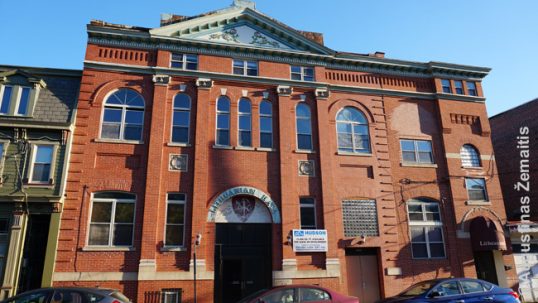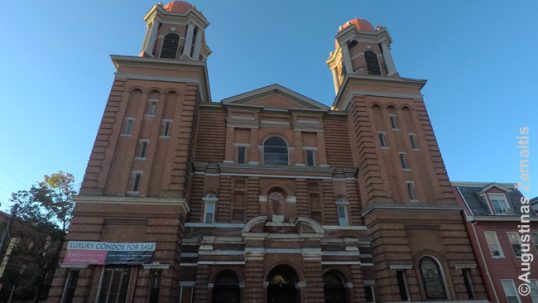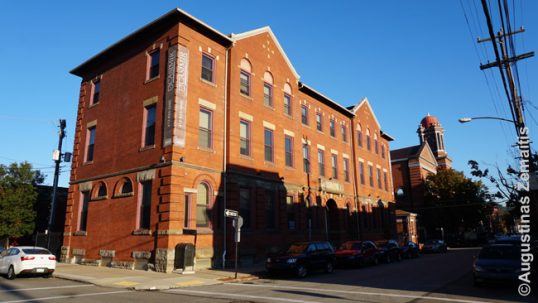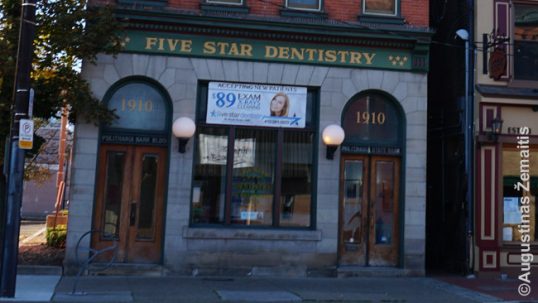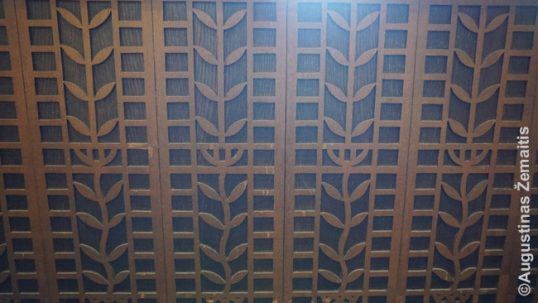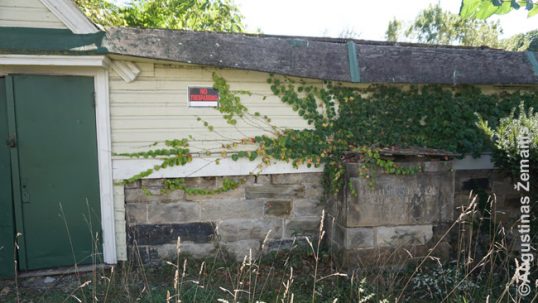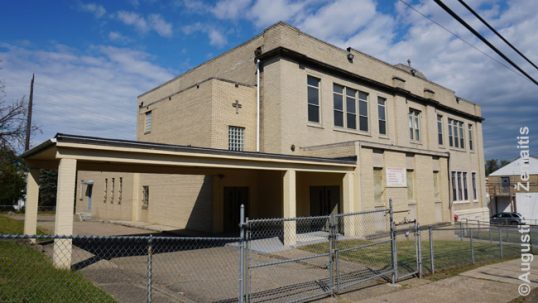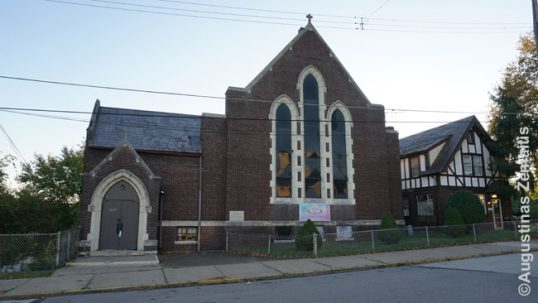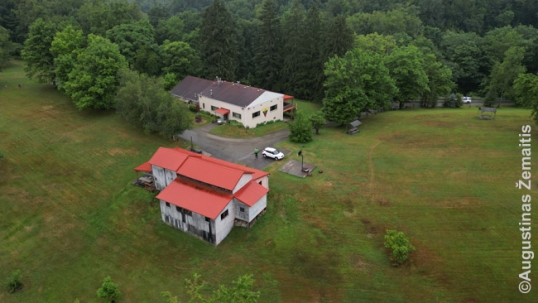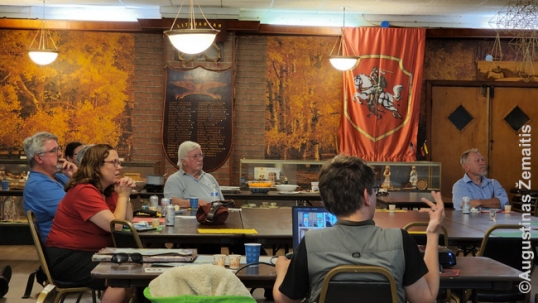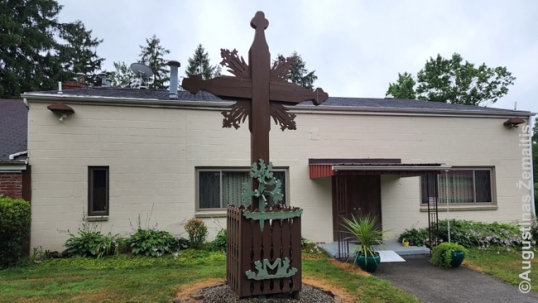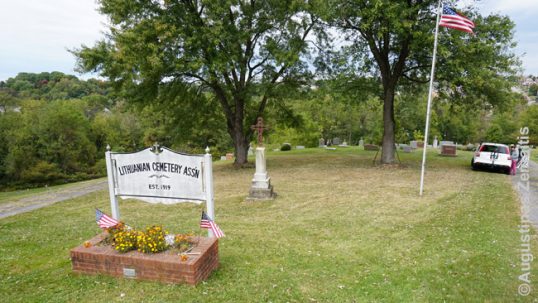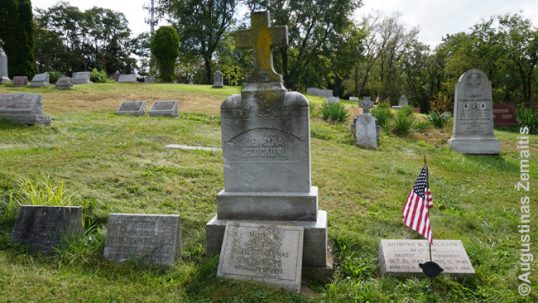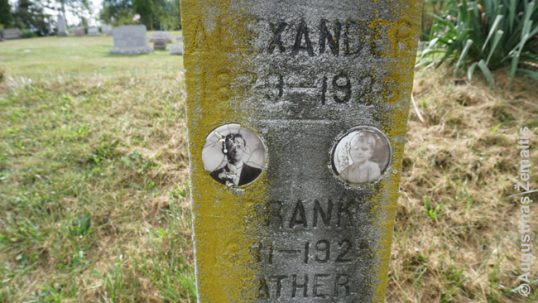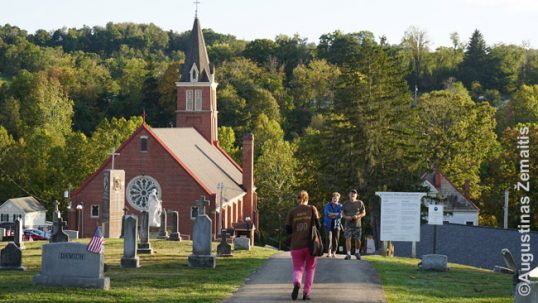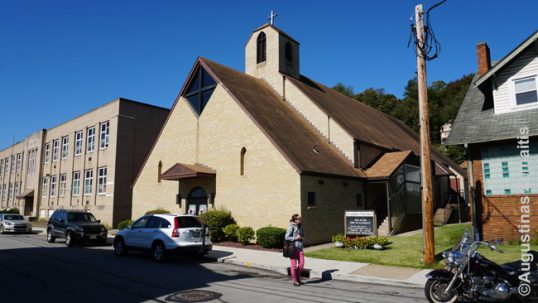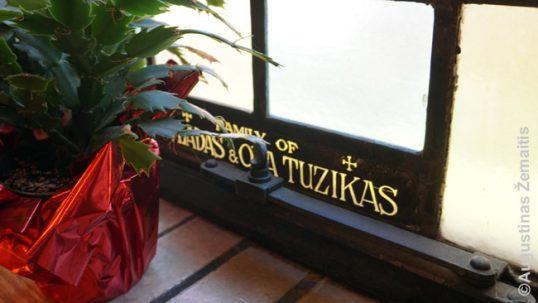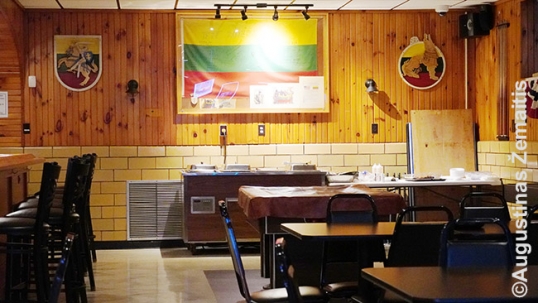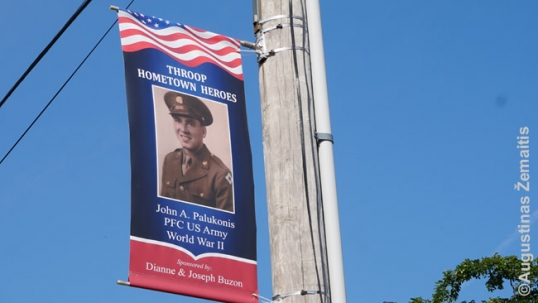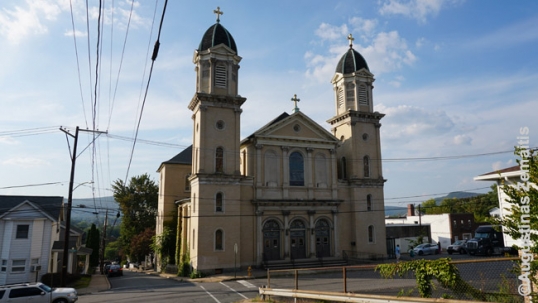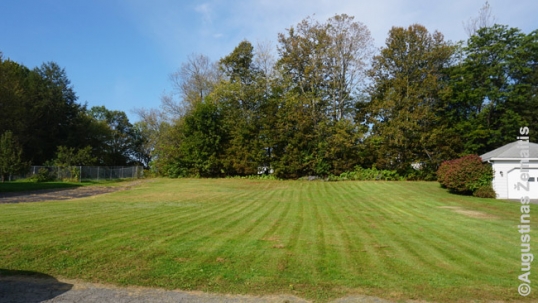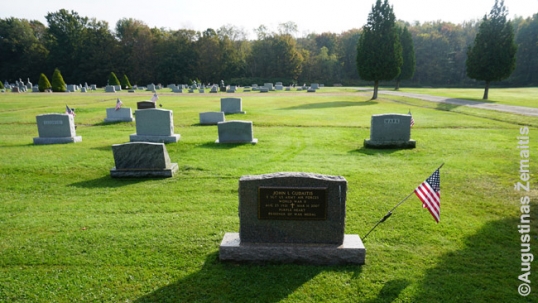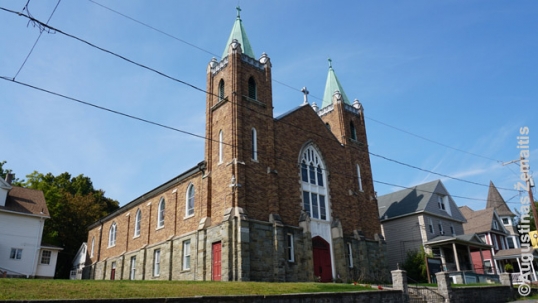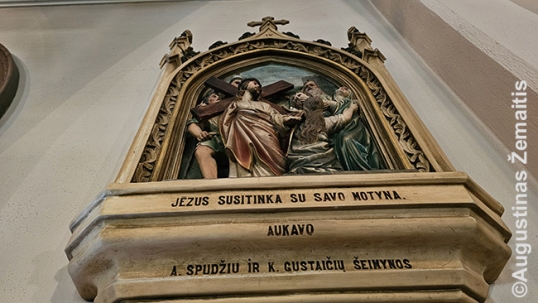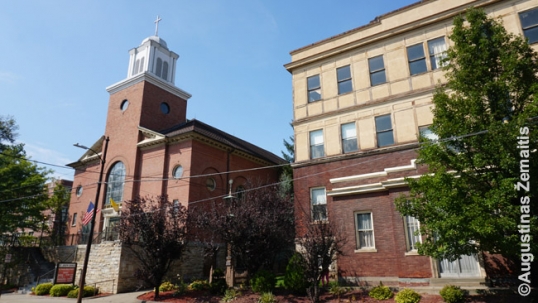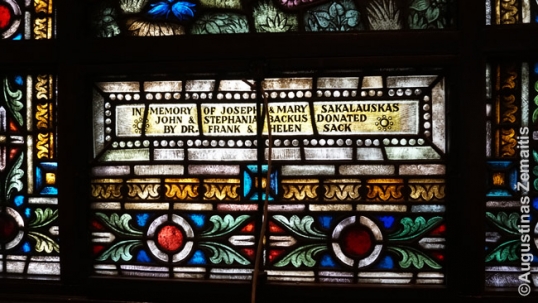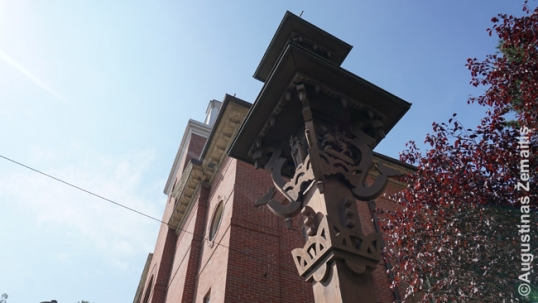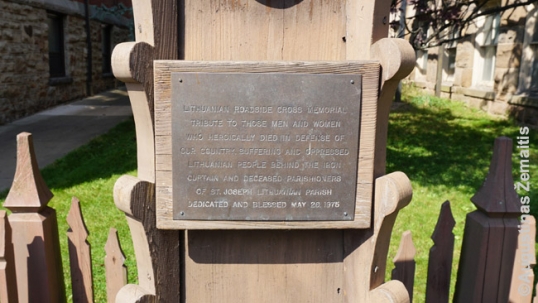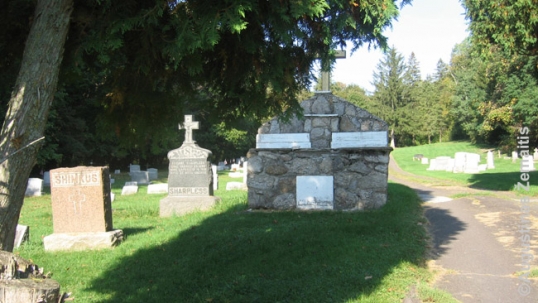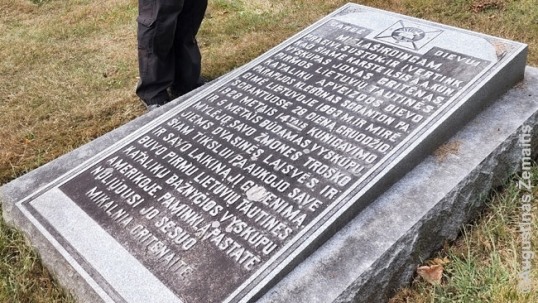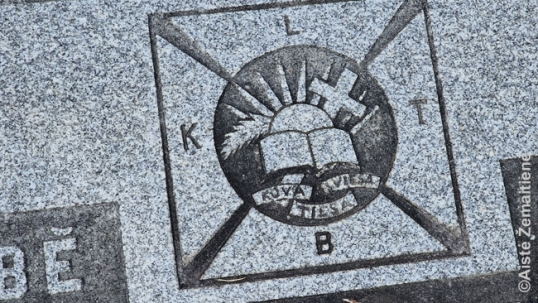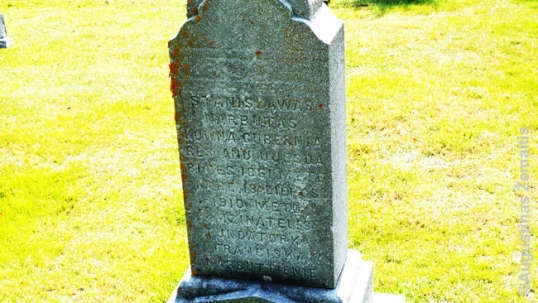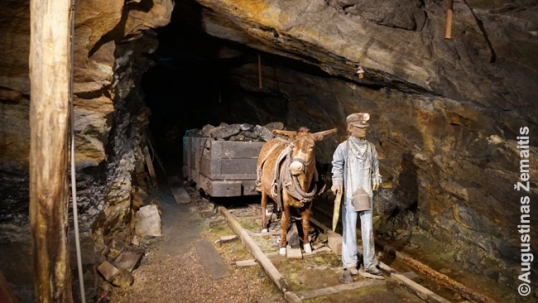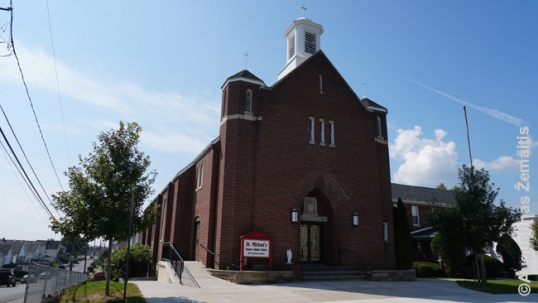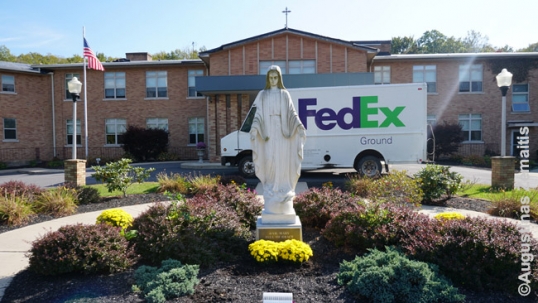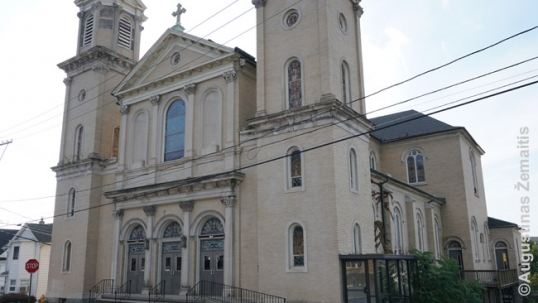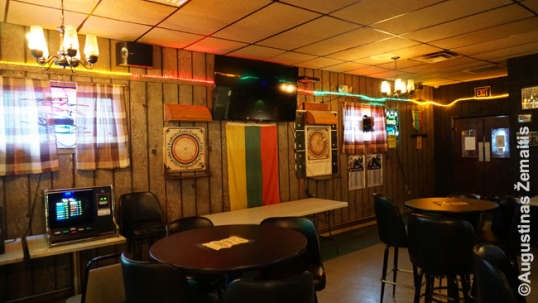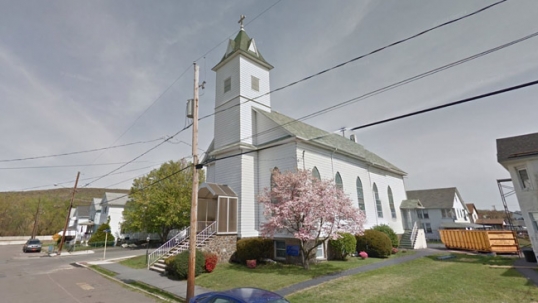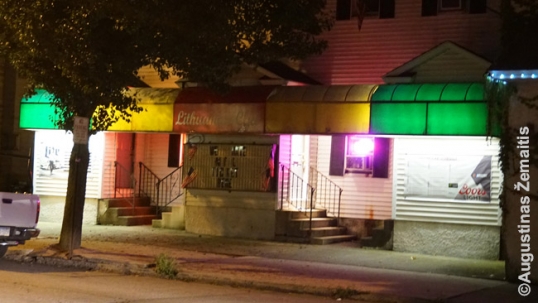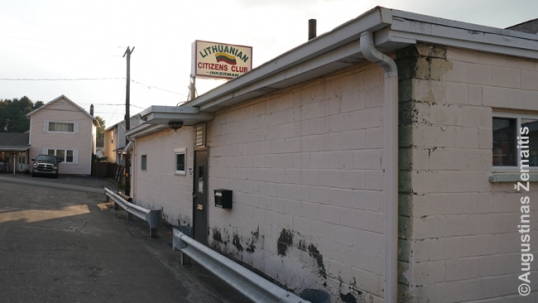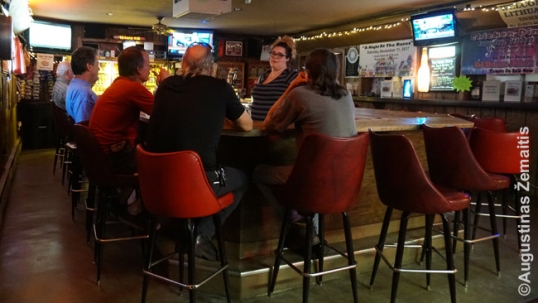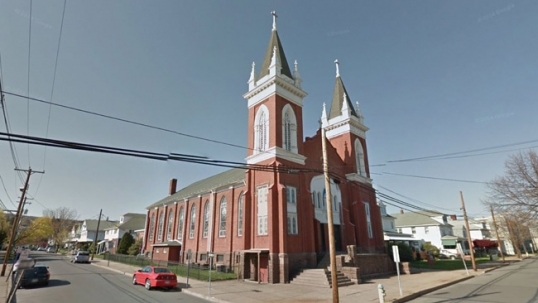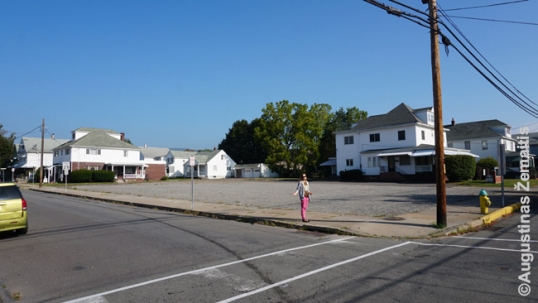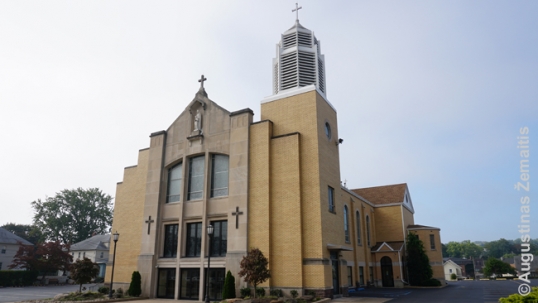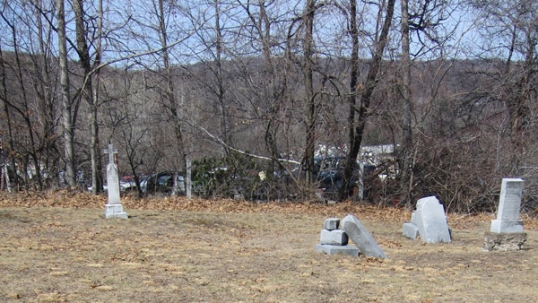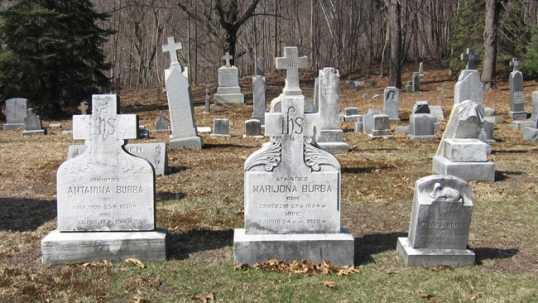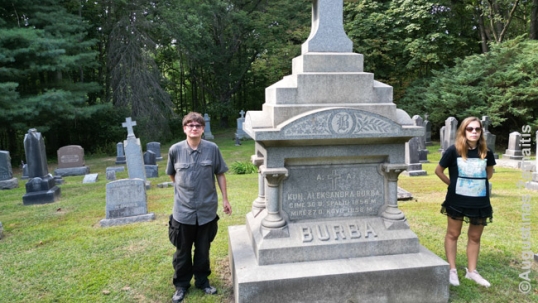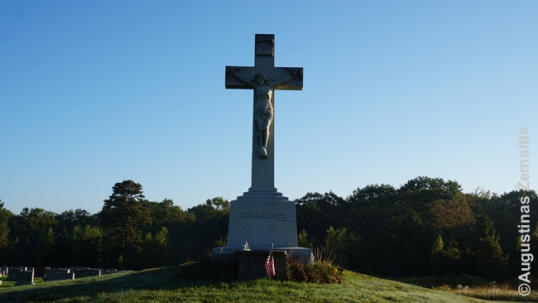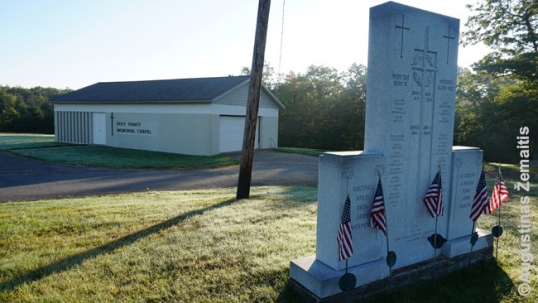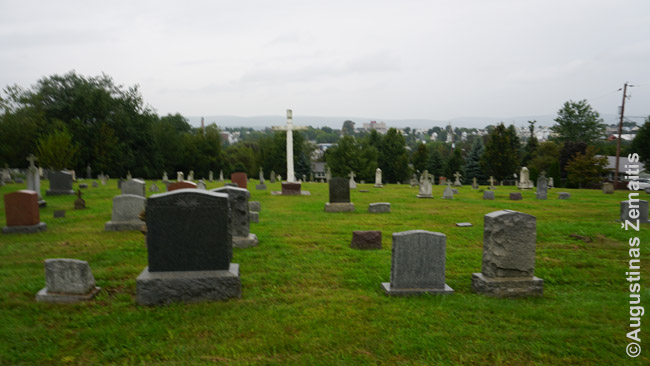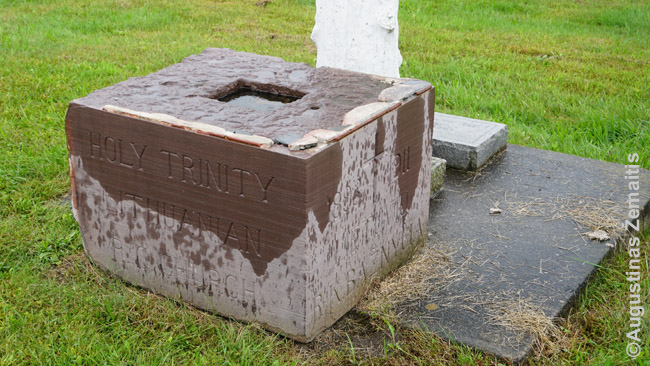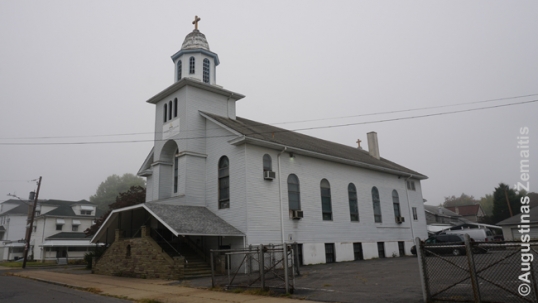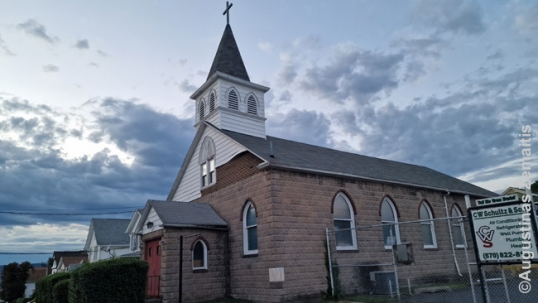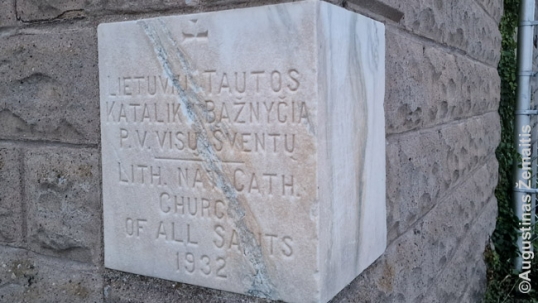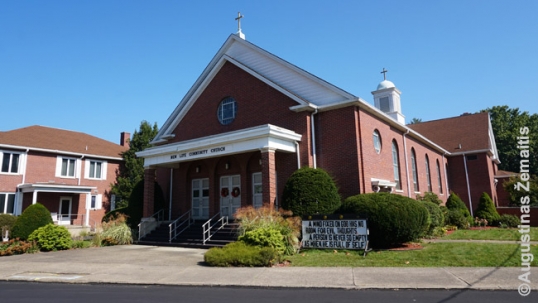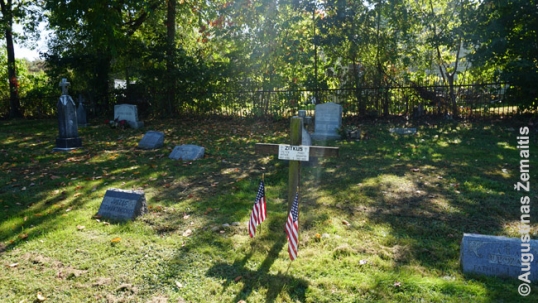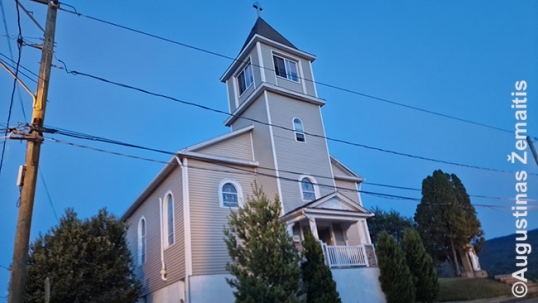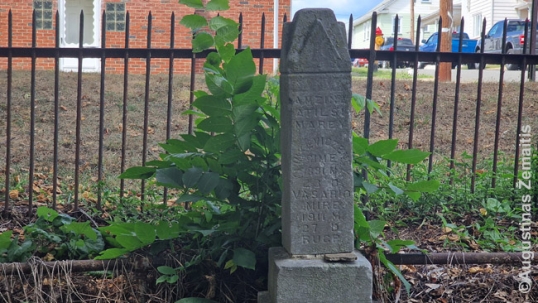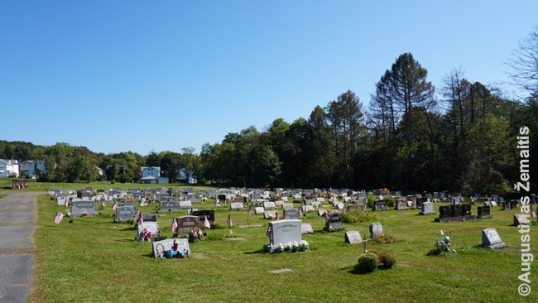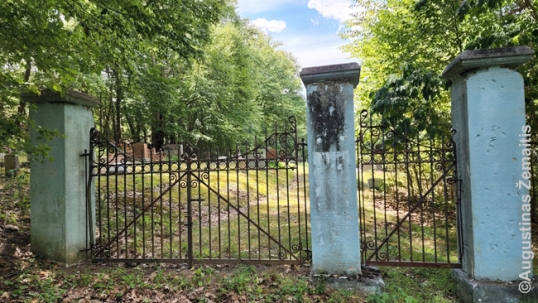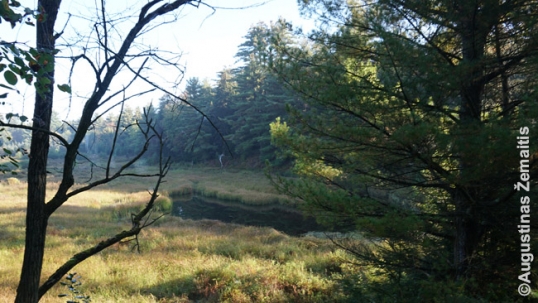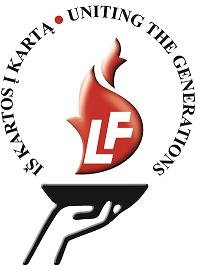Pennsylvania
Pennsylvania is the home to the world's oldest Lithuanian overseas community, started in ~1865 by coal miners. 82 000-strong it is also the second largest in the USA. Back in 1930 three Pennsylvanian cities were among the US top ten by the total number (rather than percentage) of ethnic Lithuanians: Philadelphia (3rd), Pittsburg (8th) and Scranton (10th).

Lithuanian national musical instrument Kanklės detail at the Lithuanian Music Hall in Philadelphia.
Lithuanian heritage in Pennsylvanian Coal Region
The strongest presence of Lithuanian heritage is in the parts of eastern Pennsylvania known as the Coal Region. Coal, the oil of 19th century, was discovered there in the 1860s. People from poor European regions were recruited for hard and dangerous work (10 hours a day, 6 days a week, 25 ct wage per hour) living in the newly erected towns. Lithuania was at the time occupied and heavily persecuted by the Russian Empire, giving rise to emigrants known as "grynoriai" ("Free Air Men") for whom the conditions in Pennsylvanian mines were far better than persecution back in their agricultural homeland, where the Lithuanian language had been banned and serfdom abolished only recently (1861).

Memorial plaque for Little Lithuania in the Southern Coal Regi
The Coal Region ran out of coal but the towns remained, in many of them Lithuanian populations still in their hundreds. There are lavish Lithuanian churches built of the hard-earned money by the early settlers and large Lithuanian cemeteries with their typical massive tombstones. More than 40 churches were built there. However, Lithuanian mass is no longer celebrated and Lithuanian dedications (Our Lady of Šiluva, Our Lady of Vilnius, St. Casimir, St. George) are largely removed where they existed, especially during the church closure spree of ~2008. After all, the Coal Region Lithuanian communities, unlike those in major cities, were not replenished by new immigrants and English language became dominant in the communities over some 4-5 generations. However, Lithuanian inscriptions, Lithuanian history-inspired church interiors and exteriors still remain where the churches are still used for religious purposes. It should be noted that Lithuanian church attendances were growing until at least 1980, contrary to regional trends.

'Shrine of Lithuanian history' in a Lithuanian-American church. From left to right: American, Lithuanian, and Vatican flags; the Soviet Genocide painting; the Mary painting in a folk-craft frame; the TV tower painting; the cross with images of those killed in January 13, 1991.
The Coal Region of Pennsylvania consists of two large areas.
The Southern Coal Region is centered around Shenandoah, a town that used to be known as "Vilnius of America" in the early 20th century. The area is important not only to the Lithuanian-American history but to Lithuanian history as a whole: in Shenandoah, the world's first Lithuanian novel was printed ("Algimantas" by V. Pietaris in 1904 when Lithuanian language was still banned back home), Lithuanian miner orchestra and other cultural institutions, newspapers, existed. Shenandoah had Lithuanian mayors for 42 years and it has 6 Lithuanian cemeteries. In general, Southern Coal Region consists of many small crumbling ex-mining towns, each of them having some 500-5000 people and a regular grid of streets. 15 of those towns had Lithuanian churches (despite them being just a few kilometers from each other) and many had Lithuanian cemeteries and massive schools. Some still exist, some are destroyed or abandoned. Lithuanian Days, the oldest annual ethnic festival in the USA, takes place in the area since 1914. The 20 miles wide area surrounding Shenandoah hosts many Lithuanian villages. In Seltzer (pop. 307) Lithuanians make 27,46%, in New Philadelphia (pop. 1616) - 16,97%, in Cumbola (pop. 382) - 15,06%. Lithuanian populations surpass 9% in the area's towns of Minersville (pop. 4686), Mahanoy City (pop. 5725), Barnesville (pop. 2076), Frackville (pop. 8631). All these locations are in top 20 US locations by the share of Lithuanians. Among these 20 as much as 16 locations are in Pennsylvania, 15 in the Coal Region. Much of the area is with Schuylkill county which, with 5% of its population Lithuanian, is the most Lithuanian county in the USA.

1950s postcard of Shenandoah churches (Lithuanian St. George church on the right).
The Northern Coal Region is much urbaner than the Southern Coal Region: essentially, it is one large conurbation of over half a million people, covering the cities of Scranton, Wilkes-Barre, Pittston and more. These cities each have 1%-4% of their population of Lithuanian ancestry (Pittston has the most with 4,15% Lithuanians, making it the largest share of Lithuanians in a US city of comparable size). There were 14 Lithuanian churches in the area, as well as numerous large cemeteries and impressive monuments. The Northern Coal Region Lithuanian buildings are generally bigger than the southern Coal Region ones, as they served larger urban communities rather than smaller rural ones. There are also 4 surviving-and-open Lithuanian clubs, each some 100 years old (however, these clubs, while celebrating their Lithuanian past, now tend to accept all patrons). The most unique Lithuanian site in the area is the Lithuanian national Catholic church that is independent of the Vatican. The area also has Lake Kasulaitis, which is a Lithuanian-named lake that is the furthest away from Lithuania.
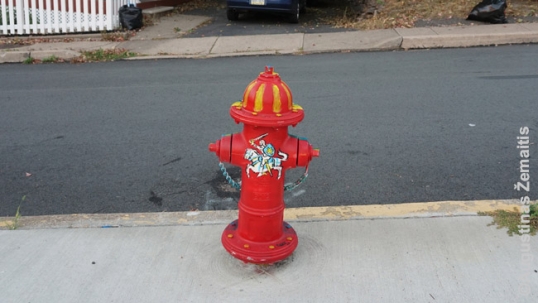
A fire-hydrant colored in Lithuanian colors near the Pittston Lithuanian club
Kasulaitis is also among a minority of surnames among those of Lithuanian Pennsylvanians which are still written as they are written in Lithuania. By the time immigration to Pennsylvania took place, there was no standardized Lithuanian orthography yet and the immigration service transcribed the surnames using various orthographies, including English, Polish or created ad hoc; they either added or removed word endings at will. Therefore in the Shenandoah Lithuanian cemetery, you may see surnames such as Bakszis and Bakszys (the modern Lithuanian spelling is Bakšys), Kutchinskas and Kutchinsky (modern Lithuanian: Kučinskas), Abrachinsky and Abraczinsai (modern Lithuanian: Abračinskas).

The grave of Publisher Bočkauskas family in Mahanoy City Lithuanian cemetery
All over the Coal Region, there are possibilities to descend into the mines Lithuanians worked at and visit museums that present authentic and quite sad life as it was.
A distant Lithuanian outpost away from everything else in Pennsylvania is another coal town of DuBois, that has Lithuanian church and cemetery.

DuBois Lithuanian church.
Lithuanian heritage in the major Pennsylvanian cities
Much larger and more lively Lithuanian community exists in the state capital of Philadelphia. There, three large Lithuanian churches operate, St. Andrew and St. Casimir churches having especially Lithuanian interiors and St. Andrew still hosting a Lithuanian school. Given that many Lithuanian churches elsewhere are closed, Philadelphia is arguably the best city in Pennsylvania or the entire USA to see the Lithuanian communities and heritage as it once was. There is also a historic Lithuanian Music Hall (older than the Republic of Lithuania itself) and other Lithuanian sites. Unlike the Coal Region where most Lithuanians are 3rd-5th generation descendants of immigrants, Philadelphia also has many post-WW2 refugees and numerous recent immigrants.
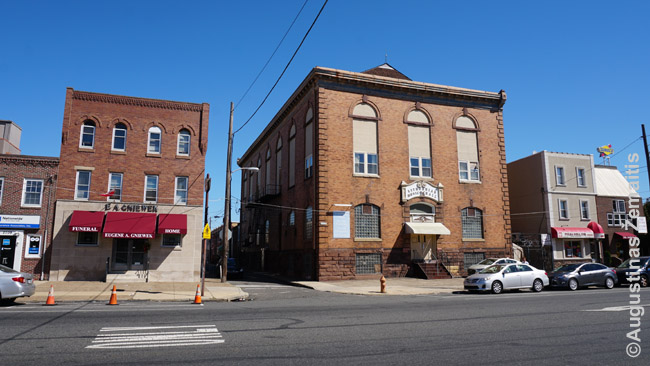
Lithuanian music hall in Philadelphia.
Yet another major Lithuanian area in Pennsylvania is located in Pittsburgh, where the Coal Region coal used to be turned into steel. Pittsburg has Lithuanian communities, cemeteries, and churches (most are closed now, though, as Pittsburg Lithuanian community also is among the old ones and the lack of Lithuanian domination in any town or region meant that it has assimilated into other communities). The most famous Lithuanian site in Pittsburgh is the Lithuanian National Classroom, an entire room of Pittsburgh university funded by Lithuania that doubles as a museum of the Lithuanian nation. It is a popular tourist site among Lithuanians and Americans alike.

Lithuanian classroom in the Pittsburgh Cathedral of Learning
There were also Lithuanian communities and churches in Easton and Reading, although both are now closed. There is a surviving Lithuanian club in Osceola Mills.

Pennsylvania map with the Lithuanian "colonies" marked. The Coal Region is marked in red, while the major concentrations of Lithuanians are written in green. ©Augustinas Žemaitis.
The map
All the Lithuanian locations, described in this article, are marked on this interactive map, made by the "Destination Lithuanian America" expeditions (click the link):
Interactive map of Pennsylvania Lithuanian sites
Shenandoah and southern Coal Region, Pennsylvania
The Southern Coal region of Pennsylvania is known as "Little Lithuania". The percentage of ethnic Lithuanians in its towns is larger than in any other area of the USA. Moreover, this region has also been important for the cultural history of the entire Lithuanian nation. Almost every town here has (or had) a Lithuanian church, cemetery, or club(s).

Memorial plaque for Little Lithuania in Shenandoah
The Lithuanian churches impress with their lavishness (knowing that everything was created by the donations of poor coal miners). Local Lithuanian cemeteries are rich in old gravestones and monuments with Old Lithuanian inscriptions telling the life stories of these immigrants. The region even has locations that are important to the history of Lithuania, not just Lithuanian-Americans, such as the site where the world's first Lithuanian-language novel was published. It also has numerous buildings with Lithuanian symbols in the facades. Lithuanian Days, the America's oldest continuous ethnic festival, is held in the area every year since 1914.

Mt. Carmel Lithuanian school facade with Vytis
Southern Coal Region countryside has numerous closed derelict closed coal (anthracite) mines which lured all those Lithuanians in during the 1860s-1910s era. The local towns are notable for their straight streets and high density of buildings. They were built that way to use up less of the valuable mining land. Nowadays, however, the population density is much lower and many buildings are derelict.

Hazleton Lithuanian church
Currently, the local Schuylkill county is the most Lithuanian one in the entire USA, with Lithuanians making 5% of local population. The locations with the most Lithuanian heritage are Shenandoah itself, Shenandoah Heights, Frackville, Mahanoy City, Mount Carmel, and Tamaqua.

Coal breaker under demolition near Shenandoah. It was among the last surviving such massive buildings that once employed many Lithuaians
Shenandoah - Vilnius of America
The heart of the Pennsylvania's Lithuanian region is Shenandoah (pop. 5500) that used to be nicknamed "Vilnius of America". Even today it is ~14% Lithuanian. The heart of Lituanity here used to be a twin-towered St. George church that had the longest Lithuanian history among the churches of the entire continent (built in 1891). It was full of Lithuanian art paid for by meager coal miner salaries. It was well on the way to be officially recognized as a heritage, yet after a controversial process and many protests, the diocese decided to tear St. George's down, despite the fact that it was the only church in the town built on solid ground. Lithuanians who collected money to list the church as heritage decided to spend it on a commemorative plaque for the Shenandoah's "Little Lithuania" (this plaque is located at the very center of the town, on the corner of Main and Centre streets).

Shenandoah St. George Lithuanian church site and the church's image
Shenandoah's nickname "Vilnius of America" is not an overstatement as the town had Lithuanian mayors for 42 years. More than that: the first Lithuanian-language novel in the world "Algimantas" has been published in Shenandoah in 1904 (its publishing house „Dirva“ stood at 15 W Oak St, whether the same building still stands is unclear). The reason for this (as well as Lithuanian migration to Coal Region in general) was that Lithuanians back home were discriminated under the Russian Imperial rule with their language banned between years 1865 and 1904.
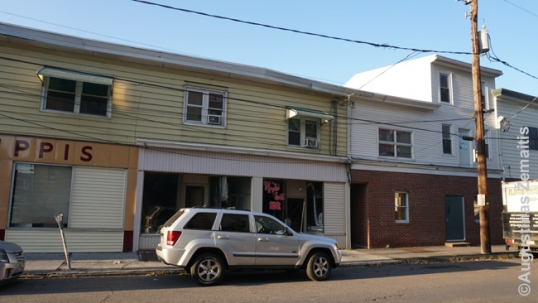
The location where the first Lithuanian novel was published
Back then, Shenandoah was a much larger town than it is today, with a population of 20 000 (40 000 according to other sources), a quarter of them Lithuanians. "Ripley's Believe it or Not" claimed Shenandoah to be the world's most densely populated locality.
The decline that happened in Shenandoah since then has been common in all the towns of the Southern Coal Region: they lost at least half of population since 1930 while some even lost three-quarters. Arguably, this helped to save the Lithuanian culture - there have been comparatively few new migrants until 2000s (Blacks, Latin Americans), therefore the old communities continue to dominate culturally. When there are so many Lithuanians, the probability of having a Lithuanian husband or wife is also not that small so there are 100% Lithuanians up to 3rd, 4th and further generations of immigrants.
The no-new-immigrants situation began to change ~2000s-2010s, however, as New York City area logistics centers were developed nearby, attracting Hispanic immigrants but the Lithuanian component is still strong.
Still, what exists today is far under what existed in 1898 when Shenandoah Lithuanians owned 59 Taverns, 17 shops, 5 meat markets, 8 stonemasons, 3 barber shops, 4 tailors, 1 blacksmith, 5 mortuaries, 5 stables and 2 publishers! Likely, Shenandoah had more Lithuanian businesses than any city within Lithuania itself, where businesses were generally dominated by the ethnic minorities (Jews, Germans, Russians, and Poles) at the time.
Among the still-existing Lithuanian-owned businesses is the Lucky's Kielbasy shop ("Lucky's" refers to the Lithuanian surname of the owners "Lukashunas"), which still offers some Lithuanian food, as well as Vernalis (Varnelis) restaurant. In general, the areas Lithuanian cuisine has somewhat drifted away from the original Lithuanian cuisine. Some dish names are partly anglicized, while the main alcoholic beverage is a typically self-produced "Boilo", the closest counterpart back in Lithuania being krupnikas, however, krupnikas is quite a niche product there, whereas Boilo is seen as the most Lithuanian drink in the Pennsylvania Coal Region.
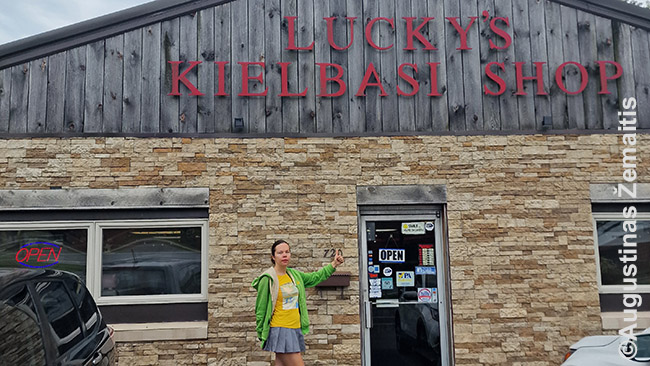
Lucky's Kielbasy deli
Shenandoah Heights Lithuanian cemeteries
The Lithuanian glory of the era may be glimpsed in six Lithuanian cemeteries of Shenandoah, located in the nearby Shenandoah Heights. This is the largest number of Lithuanian cemeteries at a single location anywhere in America. St. George Lithuanian cemetery is the oldest one, with burials dating to 1892-1934. The entrance has a Lithuanian inscription, while one of the graves not far from the entrance belongs to Rev. Andrius Strupinskas who is often claimed to be the America's first Lithuanian priest (his grave is marked by a small new plaque to be easily discovered).
In this cemetery, like in most of the Coal Region Lithuanian cemeteries, it is often better not to search for particular graves but rather wander looking at the old gravestones, reading their inscriptions, many of them in pre-modern Lithuanian language, and see the multitude of surnames: authentic Lithuanian, anglicized Lithuanian, polonized Lithuanian... After all, many of the immigrants were illiterate and their surnames would be written down by the migration officers as they heard them. Thus "Antanas Jonauskas" became "Anthony Yanousky", "Adomas Sinkevičius" - "Adam Sincavage", etc.
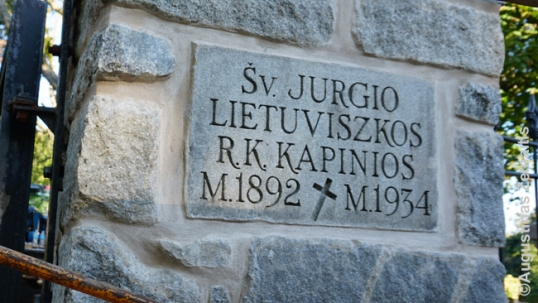
St. George Lithuanian cemetery entrance in Shenandoah
Our Lady of Calvary Lithuanian cemetery was born in 1911 out of the conflict between the priest and parishioners in the interwar St. George parish. The parishioners established their own cemetery and, having taken control of the church, even rang the bells for the funeral processions going there (the priest refused to participate in such funerals). [note: another source suggested that the Our Lady of Calvary Cemetery was established as independent in 1937 and consecrated in 1980, and the 1911 conflict happened at one of the other Shenandoah Lithuanian cemeteries]
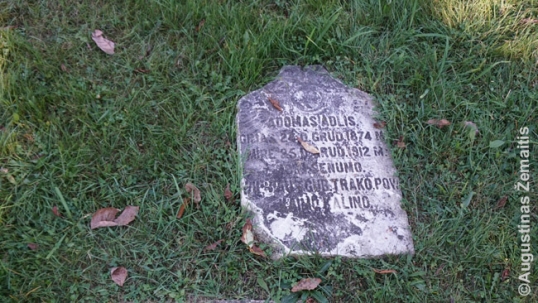
An old grave in Our Lady of Calvary Lithuanian cemetery
Conflicts like that were especially common in the early Lithuanian-American churches (~1880s-1930s), as Lithuanians who donated money for their construction did not trust that priests (some of whom weren‘t very priestlike) would take a good care of it (they feared, for example, that the Lithuanian mass would be cancelled in favor of Polish or English). Thus, they requested that the property would remain legally theirs. The Roman Catholic Church, however, required the buildings be transferred to the church.
Among the key reasons for such battles was the fact that in the 19th century, Lithuanians (and thus Lithuanian-Americans) were divided between the very religious ones and those who regarded the Lithuanian identity to be more important than Catholic identity. In the Coal Region, however, both groups went to churches, as the Lithuanian churches were both religious and secular institutions where Lithuanians would meet (also engaging in folk dances after the mass, etc.). For that second group, the secular activities mattered far more than the religious ones; these „secular Catholics“ of Shenandoah even criticised priests for too long religious ceremonies. The priests regarded these people as lost souls, and this second group was prominent among the activists for the secular-rule of the churches.
Eventually, the Roman Catholic Church got hold of the St George‘s church after numerous court battles, and the Our Lady of Calvary also became officially Catholic. Today, however, it seems that the secular activists of ~1900 have been right, as the church has been demolished and its stones may still be found at the western end of the Our Lady of Calvary Cemetery. Initially, the diocese promised that it would build a symbolic belfry for Lithuanians out of these stones, but has reneged on its promises since.

Church materials at a Shenandoah Lithuanian cemetery
There are three more Lithuanian Catholic cemeteries in Shenandoah. In Our Lady of Lourdes Lithuanian cemetery, the most impressive memorial is that for Aleksandras and Viktorija Semenis, in the form of a Lourdes grotto with Lithuanian inscriptions. The interwar Our Lady of Fatima Lithuanian cemetery boasts a Lourdes-inspired grave of priest Rev. Mssgr. Joseph Anthony Karalius, who served as Shenandoah‘s Lithuanian pastor for 41 years and is credited for achieving the final victory against the secular activists in a battle for the church property, as well as supporting anti-Soviet religious activities in Lithuania.

Semenis family Lourdes in Shenandoah

Priest Karalius Lourdes in Shenandoah
Shenandoah Our Lady of Dawn Lithuanian cemetery is usually misnamed in English: the correct translation would be „Our Lady of the Gate of Dawn“, referring to the miraculous painting of Virgin Mary in the Gate of Dawn in Vilnius, Lithuania. In this cemetery, the entrance gate with Lithuanian inscriptions and bas-reliefs is the most impressive.
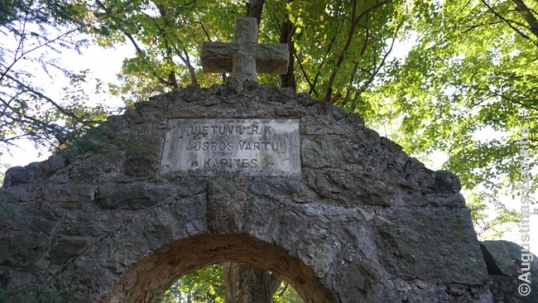
Entrance to the Our Lady of Dawn cemetery
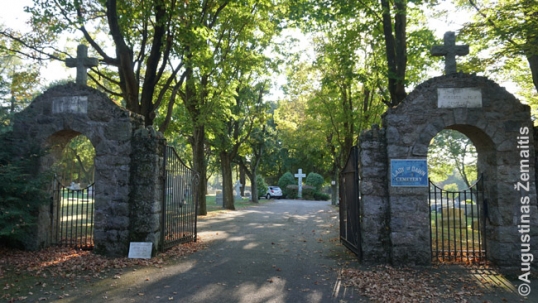
Our Lady of Dawn Lithuanian cemetery in Shenandoah

Lithuanian bas-relief in the Shenandoah Our Lady of Dawn cemetery
Moreover, Shenandoah Heights has a small and old Liberty Cemetery of the Supreme Lodge of Lithuanians in America (est. 1900) which served the similarly named local organization; it has ~50 of its members buried here. The organization was related to Jonas Šliūpas, a leftist so critical of the church that his followers typically established alternative institutions to the Catholic institutions altogether. As such organizations died off (with post-WW2 Lithuanians turning against leftism due to the Soviet Genocide in Lithuania), the cemetery became mostly abandoned.
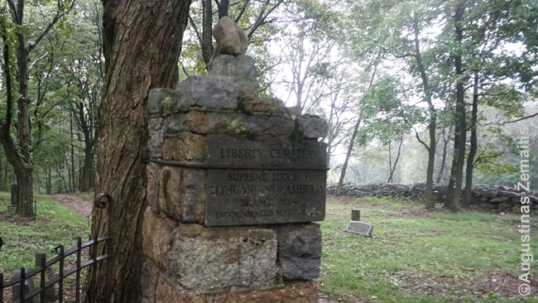
Shenandoah Lithuanian Liberty cemetery entrance
The southern side of Shenandoah Heights offers a great view of the Shenandoah town. Once, this view was dominated by the twin towers of the massive St. George Lithuanian church. The church is well-remembered as a key landmark of Shenandoah and even some advertising billboards ask the passers-by to remember it.
Shenandoah is also to receive a Lithuanian Museum, to be relocated from Frackville.
Lithuanian towns that surround Shenandoah
Merely a few miles separate Shenandoah from some other "Lithuanian" neighboring villages and towns. However, Lithuanians started moving in here at the time when the world could have only dreamt about automobiles and the intertown distances were still too big to travel on foot. Therefore, every town had its own Lithuanian church commissioned. All of them are small, usually with a single tower.
When there were so many Lithuanians, the ethnic traditions were easier to safeguard and even ~1970s the attendances of Lithuanian churches were increasing (those of other ethnic parishes were already declining). Even at ~1985 some Lithuanian parishes constructed new church buildings (therefore, although all the parishes had been established over a century ago, some church buildings are relatively new).
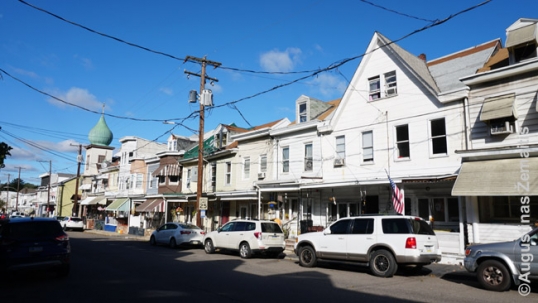
A street in Mahanoy city, a typical town of Shenandoah coal region
However, ~2008 the dioceses decided to abolish all the ethnic parishes and close their churches down. After all, Lithuanian masses had been abolished quite long ago in all of them: 3 or more generations have passed since the coal miner immigrants, thus the bishop thought there is no reason to keep multiple operating churches in small-and-diminishing towns/villages. However, the churches with their old Lithuanian inscriptions, paintings, decor are also important culturally and historically. Therefore, their communities defended them at all costs. Even though the Lithuanian language had been largely forgotten, other Lithuanian traditions (crafts, dances, food) are cherished.
In many of the area's towns you may see the images and names of the local war veterans posted on poles. By looking at these names you may easily discern the percentage of Lithuanians in the area, as nearly everybody whose surname ends in "-as" or "-is" is a Lithuanian. Those who have surnames ending in "-auski" are also Lithuanians, while those with "-owski", "-awicz", "-avich", "-avage" and similar-sounding surnames may be either Poles and Lithuanians.
Frackville Lithuanian district, museum and cemetery
One of the cities that cherishes the Lithuanian heritage the most is Frackville (pop. 4000 today, 8000 in 1930). It has an entire district of Lithuanian institutions around the Annunciation BVM Lithuanian church in Frackville. „Apreiškimo Panales Švenč Banyčia 1934“ inscription still adorns the cornerstone, although the church is now irregularly used. The interior includes stained-glass Windows with Lithuanian inscriptions, Our Lady of Vilnius painting, while the tower is crowned by a Lithuanian sun-cross. As the church is no longer officially a Lithuanian parish, some other Lithuanian details were removed (a recurring story in the Southern Coal region).

Frackville Lithuanian church
The nearby Lithuanian Museum and Cultural Center has been closed down in 2022, to be relocated to Shenandoah (see above). Established in 1982, it offered artifacts of the 19th-century Lithuanian immigrants, the once-cherished Lithuanian memorabilia which the Lithuanian-Americans were able to somehow acquire from the far-away and later Soviet-occupied Lithuania. This includes various manifestations of Lithuanian folk arts and crafts: kanklės traditional musical instruments, traditionally painted easter eggs (margučiai), straw ornaments, traditional crosses. Some of them have actually been created by local Coal Region Lithuanians, many of whom have actually never even visited Lithuania but still cherish the traditions passed on by their forefathers who may have immigranted ~1900. The museum also hosted exhibits explaining the Lithuanian-American life of the Coal Region (e.g. the symbols of once-numerous fraternity organizations). If you visited with somebody who knows the exhibits well, they could have told you many more stories, e.g. the exhibited funeral photos used to be sent through the Iron Curtain in order to inform on who is dead and who is alive at the time in the family without triggering censorship.

Frackville Lithuanian museum sign
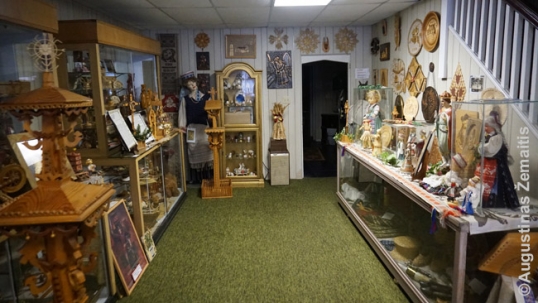
Inside the Frackville Lithuanian museum

Fraternity symbol in Frackville museum
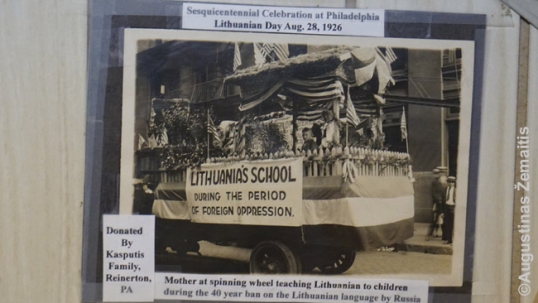
A Lithuanian rally in the 1920s as it appears in a Frackville Lithuanian museum image
Yet another Lithuanian building there is the Annunciation BVM parish hall (1957) that used to host Lithuanian Days in the 2010s, since moved elsewhere.
Away from its Lithuanian district, west of the town, Frackville hosts a large Frackville Lithuanian cemetery where not only Frackville Lithuanians but also Lithuanians from some other Lithuanian parishes used to be buried. Nominally, it consists of several cemeteries.
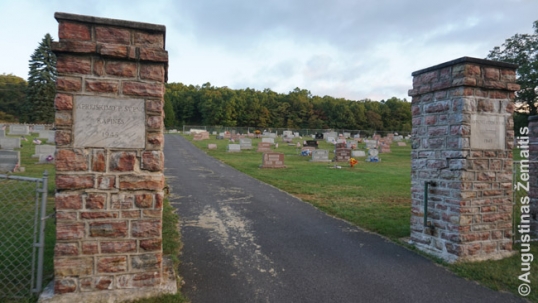
Entrance to the Frackville Lithuanian cemetery
Mahanoy City: Lithuanian church and cemeteries
In the same way as Shenandoah is important to Lithuanian literature, Mahanoy City (pop. 4 000 today, 16 000 in 1910) should be known to every fan of Lithuanian musical history. The coal miners of years-gone-by have established the world's first Lithuanian wind instrument orchestra ("Mainerių orkestra").
The town has a St. Joseph Lithuanian church, the area‘s oldest Lithuanian church (erected 1888-1893). Unlike in the other towns, where Lithuanian churches closed and Lithuanians were told to go to some once-non-Lithuanian parish, in Mahanoy City, all the parishes have been consolidated into the Lithuanian church in 2008. Therefore, it is the Lithuanian church that continues to be open, albeit now renamed after Mother Theresa of Calcutta, who visited it in 1995. Such parish consolidations, however, often mean that the one remaining church is renovated, thus losing some of its original ethnic details. For example, all the saints of the closed Mahanoy City churches have been painted over the altar, and new murals have been created all over the church. One Lithuanian thing remaining in the church is its stained-glass Windows. However, these are not authentic 19th-century stained-glass Windows. Most of these were replaced by new ones in the mid-20th century – while the surnames of the donors are still Lithuanian, the inscriptions themselves are not as, by this time, the Coal Region Lithuanian community increasingly spoke English as its first language. Only near the chorus do the original windows with Lithuanian inscriptions survive. On the outside, additional wall has been built parallel to the church where stained glass windows from the closed non-Lithuanian churches of Mahanoy City have been put on.

Mahanoy City Lithuanian church
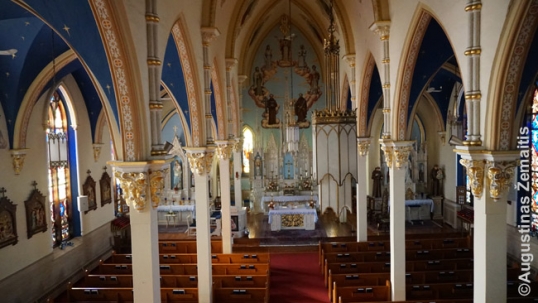
The interior of the Mahanoy City Lithuanian church
Mahanoy City used to have numerous Lithuanian buildings buildings, however, most have been demolished in the 2010s-2020s.
Mahanoy City has been famous once as the location where the world‘s-highest-circulation Lithuanian newspaper „Saulė“ was published. Its massive three-floored wooden publishing house (1916) stood derelict until 2021, when it was demolished (the newspaper had its final issue in 1959 as the Lithuanian language use declined in the area; it had been established in 1888).
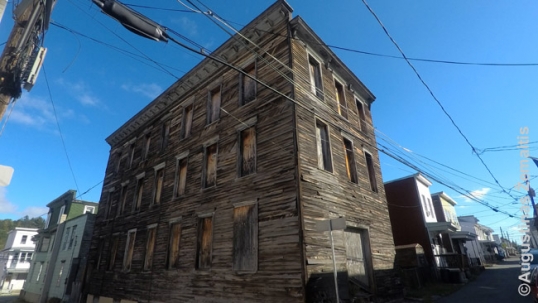
Saulė Lithuanian newspaper publishing house in 2017 (now demolished)

The facade of Saulė publishing house in 2017 (now demolished)
Lithuanians also had a Lithuanian bank in Mahanoy City, unfortunately, the building has been demolished in 2023. Interestingly, the bank has been established by a Lithuanian priest (Simonas Pautienius) as, at the time, ethnic minority banking was considered to be a social service more than a business, as the American banks often refused to lend to the immigrants. As the time passed and such discrimination ceased, the bank lost its raison-detre and merged into another bank in the 1940s, with building eventually becoming disused. The inscription on the building top said „1903-1923“. The bank is claimed to have been the first Lithuanian bank in the USA.
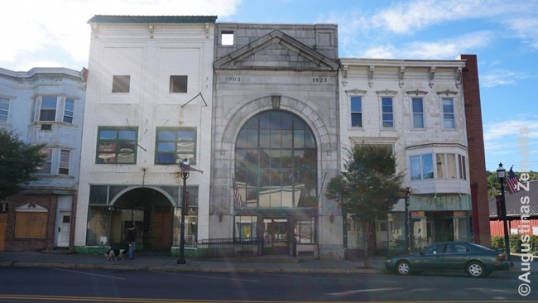
Mahanoy Lithuanian bank (the one with arched window)

The interior of Mahanoy Lithuanian bank
Mahanoy City had even more Lithuanian buildings: the Lithuanian school has been demolished in 2010 (closed down in 1972) to be turned into a newly-amalgamated parish's parking lot, while the Lithuanian convent still stands, however, there are no Lithuanian details survive there.
Outside of the town limits to the south, amidst the other cemeteries, stands the St. Joseph Lithuanian cemetery. The most important grave there is that of the Bočkauskas family, the publishers of „Saulė“. Interestingly, on some of this family's gravesypmes the surnames are written in Polonized (Bockowski) and some in prie-modern Lithuanian orthography (Boczkauskas), likely showing the rift that existed between those Lithuanian-Americans who emphasized their Lithuanian identity and those who preferred Polish as the „elite language“.

The grave of Publisher Bočkauskas family in Mahanoy City
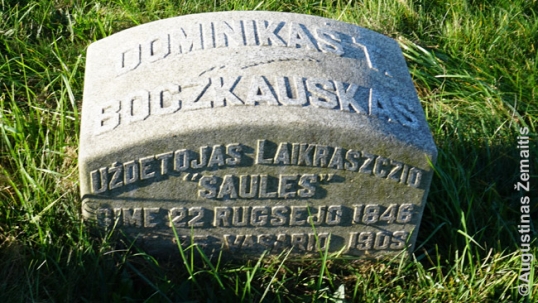
Saulė publisher grave in Mahanoy City
North of Mahanoy City stands another, far sadder-looking Old Lithuanian Cemetery. It is entirely abandoned, overgrown with trees, many of its gravestones overturned. That cemetery was established by the Mahanoy City St. Joseph parish in 1922, as the Lithuanian inscription on the gate says ("1922 m."). However, then it turned out that the ground is unsuitable for burials due to ground water. A new cemetery was thus opened (see above) and the people were encouraged to rebury their relatives there. However, this cost money, and thus some Lithuanians remained buried in the old cemetery which is now not being taken care of.

Abandoned Old Lithuanian Cemetery of Mahanoy City
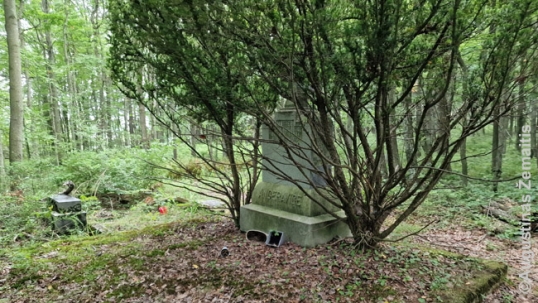
Abandoned Old Lithuanian Cemetery of Mahanoy City
Maizeville and Girardville: Lithuanian churches and a street
Maizeville village had the USA's sole Our Lady of Šiluva church (14 North Nice Street), named after the oldest church-recognized Marian vision in Europe that took place near the village of Šiluva in Lithuania. It has been constructed in 1967 after the old one burned down. The old church used to be been named St. Louis - however, the parish, even though already dominated by American-born Lithuanians, decided to adopt a more Lithuanian name for its new building. On the inside, they have commissioned many Lithuanian details and impressive stained-glass windows which were condemned for removal as the church had been closed.
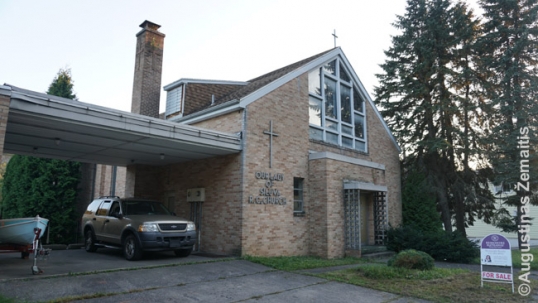
Maizeville Our Lady of Šiluva Lithuanian church
Maizeville and the nearby Gilberton lost extremely many people even by Coal Region standards: in 1910 they had a population of 5500 yet only 750 live there today. Maizeville still has an Our Lady of Siluva Boulevard (actually a small side-road that once served as a highway on-ramp; after the highway closed, the name of the nearby church was given to it). Unfortunately, there is no street sign and the name thus appears on the maps alone.
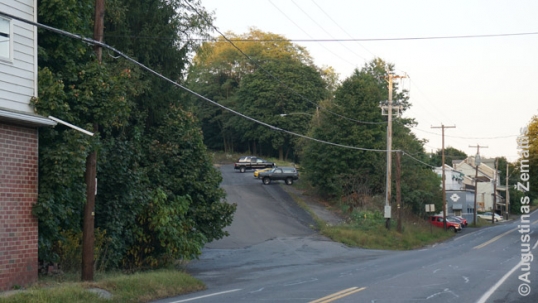
Maizeville Our Lady of Šiluva boulevard
Girardville's (pop. 1500 today, 5000 in 1930) Lithuanian hub used to be its St. Vincent de Paul church. The city‘s first Lithuanian mass has been celebrated in an opera theater at 27 E. Main St. (as the town turned into a village, it became a cinema, roller skating hall and finally has been demolished). The current brick English gothic revival church has been built in 1926, its lavish interior simplified in 1978. It includes Lithuanian stained-glass windows. Although no Lithuanian mass has been held for a long time, the parish celebrated its Lithuanian minority heritage until its closure. The beautiful stained-glass windows remain, including one with a Lithuanian flag and the Cross of Vytis symbol. There are many Lithuanian surnames written under various works of art as those of their donors. The official website of the former parish declares that "our roots will always be in Lithuania". While the parishes were consolidated, the church was allowed to stay open initially but ~2020s it saw little use.
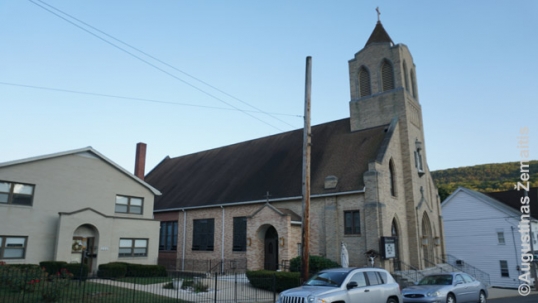
Girardville Lithuanian church

A stained-glass window at the Girardville Lithuanian church
Further south: Lithuanian heritage at 209 road
209 road ~15 miles south of Shenandoah has much of Lithuanian heritage in the towns along it.
Tamaqua town has the second still-open Lithuanian church of the region (St. Peter and Paul, 307 Pine St.), which is also an impressive example of Lithuanian modern art as its interior has been crafted by a famous Lithuanian-American sculptor-architect V.K. Jonynas (1976) in his unique style. The tower is crowned by a Lithuanian sun-cross. The Lithuanian flag, however, has been moved out while the wooden external cross was removed and replaced by a simple non-Lithuanian-styled one: Allentown diocese has been especially tough on the ethnicity of the churches so, while such things as Lithuanian crosses remained in the ex-Lithuanian churches elsewhere, they were almost invariably removed in the Southern Coal Region (except for the details too expensive to replace, such as the stained glass Windows). ~2018, a massive renovation in the Tamaqua church has also removed large swatches of original style that once formed the church as a single whole. Stations of the cross were replaced by the ones moved from another closed church, the altar side has been remodeled, the tower shortened (due to water leakage), and the front sculptures removed. The details that were removed still exist in the parish, albeit in other places (e.g. in the sacristy). Before the current Tamaqua church was built, Lithuanians used a building behind it as a church, as well as a school. That building still stands (constructed in 1927). While the remodeling removed some of the original character, they ensured that this church continues as the main church of Tamaqua, thus, it has not been closed (albeit renamed from St. Peter and Paul to St. John XXIII).

Tamaqua Lithuanian church
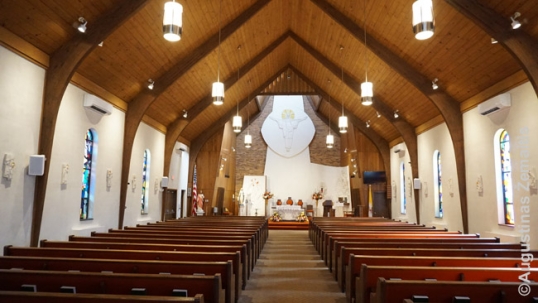
The interior of Tamaqua Lithuanian church
Tamaqua is one of the larger towns in the area with 7000 inhabitants (13 000 back in the "golden days"). It had 106 Lithuanian families in 1906 and 235 Lithuanian families in 1917; given the size of the families back then this may have made up 5-10% of population. Those families now lay at Owl Creek Road, where there is St. Peter and Paul Lithuanian cemetery (1929). The most impressive there is a derelict freestanding gate without any fence remaining. Two Lithuanian tricolor motifs are still visible on the gate, as are the words „Lithuanian cemetery“.
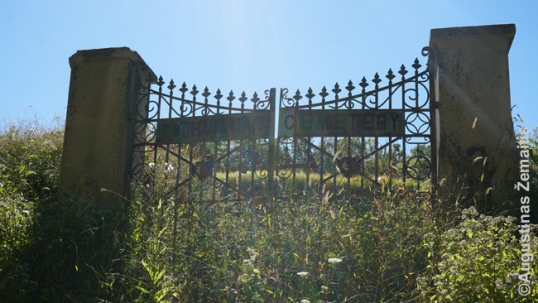
Tamaqua Lithuanian cemetery gate
The same cemetery was also jointly used by a parish ~5 miles east in Coaldale based in a white St. John the Baptist church. This church has been closed while the town itself lost nearly three-quarters of its population decreasing from 7000 to 2000 people. A Lithuanian inscription „Šv. Jono Lietuvių R. K. bažnyčia“ still remains on its cornerstone. It bears the date of 1914 05 10. After closure, this church was bought by a local person who was attached to it as he married his Lithuanian wife there and baptized their children there. Living in the rectory, he left the church mostly as it was. The diocese itself, however, after selling the church, tried to remove stained-glass-windows and the cornerstone but the parishioners and the new owner fought against this. Still, the diocese has removed the Lithuanian names of the church donors from the stained-glass windows.

Coaldale St. John Lithuanian church
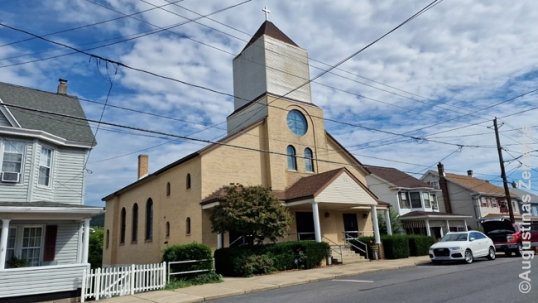
Coaldale St. John the Baptist Lithuanian church
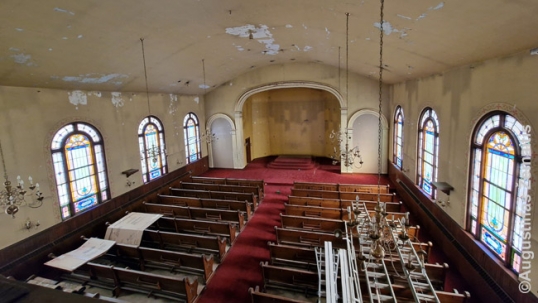
Coaldale St. John the Baptist Lithuanian church interior
Shenandoah is the most Lithuanian US town among those above 5000 inhabitants but if you count all the villages with population above 1000, New Philadelphia, that title belongs to New Philadelphia. ~25% people there are Lithuanians (more than of any other single ancestry). In 1910, when the village was double in size, there was a confrontation between two ethnicities: Lithuanians and Irish. Both established their own church and both remained open nearly until these days. Unfortunately, in 2008 the Lithuanian Sacred Heart church was closed (its building constructed in 1984). Now it serves as a church-owned café open weekly; the café still offers a Lithuanian kugelis, although all the Lithuanian symbols (such as Rūpintojėlis) have been removed by the diocese.

The former New Philadelphia Lithuanian chruch
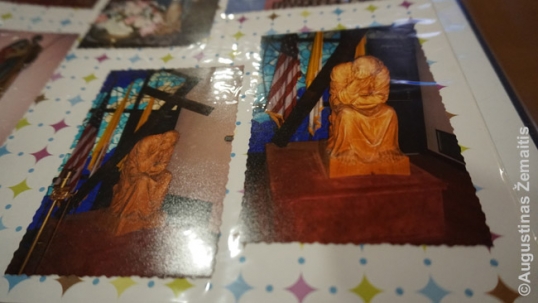
Rūpintojėlis that was thrown away by the Allentown diocese
To better understand just how massive Lithuanian community of New Philadelphia was, you may see its Lithuanian school (abandoned, no Lithuanian details, built in 1926) and equally massive (for such a village) Sacred Heart Lithuanian cemetery.

New Philadelphia Lithuanian school

New Philadelphia Lithuanian cemetery
The village of Middleport still had so many patriotically-minded Lithuanians in 1948 (some 50 years after the Lithuanian mass-migration into the region) that they built an entirely new church there (not simply replacing an older one). However, a new Lithuanian parish was not created there, so priests from New Philadelphia used to come to celebrate the mass. The church is now closed and it has no Lithuanian details.

Middleport Lithuanian church
Minersville (pop. 4000 today, 9000 in 1930) Lithuanian parish of St. Francis of Assisi (1950) has been also condemned but its people achieved an impressive victory in Vatican. After their complaint, Vatican recognized that bishop illegally closed down their church. Unfortunately, the bishop refused to concede and decided to reopen the church merely symbolically (for a single holy mass celebration annually). Then, in the 2020s, it was decided to close the church down completely citing "little use of the building" as a reason. With the old Lithuanian parish community already disintegrated, this decision was left unchallenged.
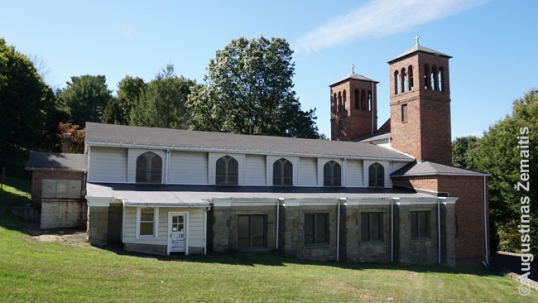
Minersville Lithuanian church
On the hill above the church, there is the former Lithuanian school (open as a non-Lithuanian school without surviving Lithuanian details).
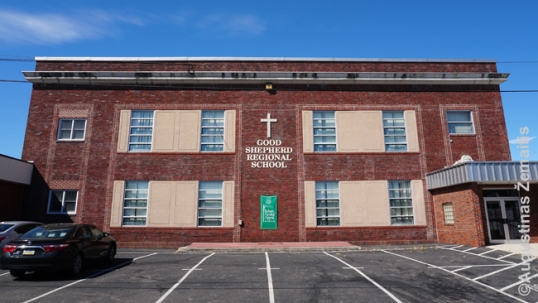
Minersville Lithuanian school
Minersville also has two Lithuanian cemeteries. The larger one by far is the Catholic Lithuanian Cemetery with a World War 2 memorial. There is also an eerily abandoned Lithuanian Liberty Cemetery by the hillside.
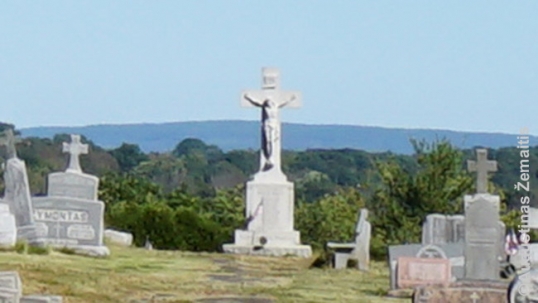
Minersville Lithuanian cemetery and World War 2 memorial

Lithuanian Liberty Cemetery of Minersville
St. Clair town (pop. 3000 today, 7000 in 1930) also saw its St. Casimir Lithuanian church (441 South Nicholas St., constructed in 1917) closed down during the campaign against the ethnic churches ~2010. The building is abandoned, with even the mass plaque with its final priest‘s name (Jankaitis) still adorning the wall.

Saint Clair Lithuanian church

St. Clair church information with a priest's surname
St. Casimir Lithuanian cemetery (est. 1929) remains near St. Clair, and the St. Casimir statue is its prime sight. Another Lithuanian cemetery (non-religious) is known as Sons of Lithuania cemetery and is located west of town together with St. Mary's Byzantine cemetery (without a visible separation).

St. Casimir in the St. Clair Lithuanian cemetery
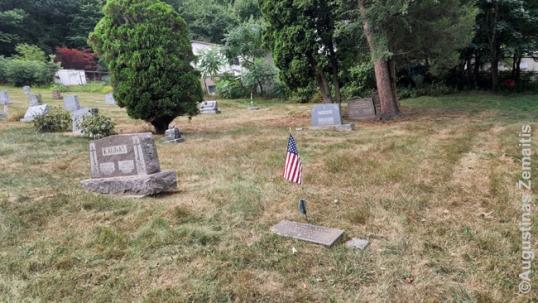
Sons of Lithuania cemetery in St. Clair
The areas south of Shenandoah also host the Pennsylvania Lithuanian Days. This is the longest-continuously-running annual ethnic festival in the USA, taking place every year since 1914. In 1922-1984, and since 2021, they take place in Lakewood Park. Currently, the timing is the closest weekend to the day of Virgin Mary Assumption in August. Previously, there used to be one Lithuanian day and it used to take place even if it did not fall out on Sunday. Lithuanians would take a holiday that day and descend on the Lakewood Park and the coal mine owners knew its better not to dispute this by requiring Lithuanians to work. It is said some 13 trains would go to Lakewood Park that day. It was also common to raise Lithuanian flags that day - a tradition that still survives to some extent and you can still see Lithuanian tricolors if you drive around the region in mid-August. The Lithuanian Days include Lithuanian music, fair, dances, and history-related activities.
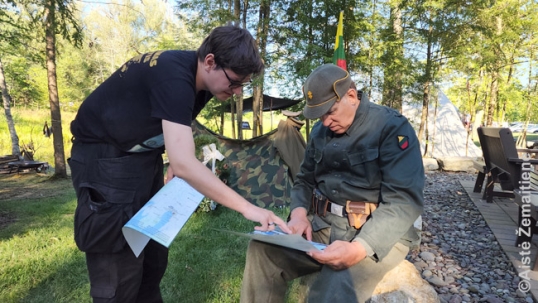
In a Lithuanian partisan camp during the Lithuanain Days
Lithuanian heritage west of Shenandoah
Mt. Carmel township (pop. 6 000 today, 18 000 back in 1930) was the hub of Lithuanian activities in the western Southern Coal Region. It still has a Lithuanian Social Club (309 S. Oak St.), established in 1926, with a door painted in Lithuanian tricolor. The club moved to this building in 1932. The club is among the most inclined to keep the Lithuanian heritage among the Lithuanian clubs of Pennsylvania's coal region, thanks to the young enthusiasts of Lithuanian heritage. Today, only a minority of its ~400 members are Lithuanians but, nevertheless, the club keeps the Lithuanian traditions and has many Lithuanian memorabilia inside. The club, open every day, also helping lonely people to socialize.
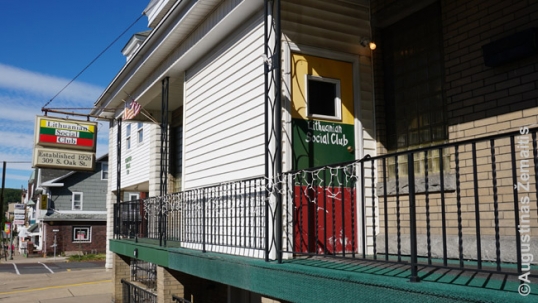
Mount Carmel Lithuanian club
Mt. Carmel also has a massive Holy Cross Lithuanian cemetery (south of town, Cemetery road). It was named after a Lithuanian church, closed in 1992 and now used as a warehouse, partly derelict, with many of its windows broken. The church is among the oldest in the area, its construction having begun in 1892 according to the Lithuanian cornerstone („St. Krizaus liet. bazniczia 1892“).

Mount Carmel Lithuanian church

Mount Carmel Lithuanian cemetery
The most important building in Mt. Carmel is, arguably, the
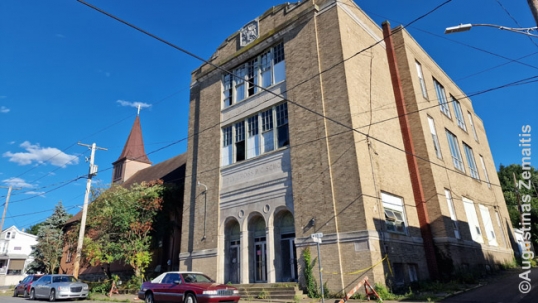
Mount Carmel Lithuanian church
Marija Kaupas, a Lithuanian nun, used to work in Mt. Carmel (she is on the route of canonization and a street has been named in her honor in Chicago). A center of voluntarism used by the Bucknell college has been named Mother Maria Kaupas Center for Volunteerism (est. 2015). Students live there temporarily, performing good deeds.

Maria Kaupas centre for volunteerism site
Shamokin town has been famous for America's first Lithuanian publishing house (which published Lithuanian-English dictionary by Markas Tvarauskas). It also had a Lithuanian St. Michael Archangel church (Cherry St.) that was closed in 1995 and demolished in 2015, although its basement stilll remains. Shamokin‘s Lithuanian club in nearby Coal Township was closed down for good during the COVID pandemic (~2020) and never reopened. The only Lithuanian institution that still remains is thus the Shamokin's Lithuanian cemetery (all of the town's cemeteries are located in a single area in the southeast next to coal mining remains, but the Lithuanian cemetery is separated from the others by the grove).

Shamokin old Lithuanian church, partly demolished (since 2015) on the left. Only the basment remains.

Shamokin Lithuanian club

Shamokin St. Michael Lithuanian cemetery
An interesting location on the way from Shenandoah to Mount Carmel and Shamokin is Centralia, a town that was demolished due to mine fires under it that sometimes led to smoke above ground.

Abandoned village of Centralia
While the town of Ashland has no Lithuanian clubs or churches, it has many people of Lithuania heritage. It also houses an original coal mine where one may descend to as well as an Anthracite museum that presents mining mostly from technological (rather than cultural) standpoint. There are no direct mentions of Lithuanians but the life these Lithuanians endured is represented.

Going inside the Ashland mine
Lithuanian heritage east of Shenandoah
The area's largest town east of Shenandoah is Hazleton (pop. 17 000 today, 38 000 back in 1940). Its brownish Sts. Peter and Paul's Lithuanian church (constuction began on 1911) used to be an extensive multiple-building complex. Unfortunately, it all has been sold in 2010 by the diocese and now serves as a Spanish Pentecostal church. Lithuanian-language cornerstone remains, however. Hazleton Lithuanian cemetery is at the Cemetery road / E Broad corner, offering numerous old inscriptions. The Hazleton Lithuanian parish was established in 1896 and is one of the oldest in America.

Cornerstone of the Hazleton Lithuanian church

Hazleton Lithuanian cemetery
McAdoo (pop. 2000 today, 5000 back in 1930) had a wooden St. Casimir Lithuanian church near the Cleveland and Adams street corner (it has been transformed into a residential house). It is interesting that this church has been born out of anti-Roman-Catholic sentiment as its builders planned to stay independent of Vatican. However after the works had begun in 1928 they disagreed among themselves and were short on money, therefore, they went back to Roman Catholicism. The completed church then served as Roman Catholic, although the congregation was never big enough to support a separate parish.

McAdoo Lithuanian church, now a detached home
The hard labor conditions in the mines led Lithuanians to protest but back then the worker's rights weren't that much protected. This had some tragic outcomes: a few Lithuanians have been killed by police in 1897 when they stroke and illegally marched in Lattimer town. 19 workers died that day and they are commemorated by a plaque in Harwood which declares that the victims were "Poles, Lithuanians, and Slovaks". A bigger memorial stands at the site of the massacre; a victim list there has a single obviously Lithuanian surname (Tomashontas) but more people may have been Lithuanians as in that era Lithuanian language was not standardized yet and surnames changed after migration. Lattimer massacre became well known in the USA and it caused the trade union ranks to swell. In spite of this, many Lithuanians who disliked the local conditions left the Pennsylvanian coal region for surrounding states, e.g. Upstate New York.
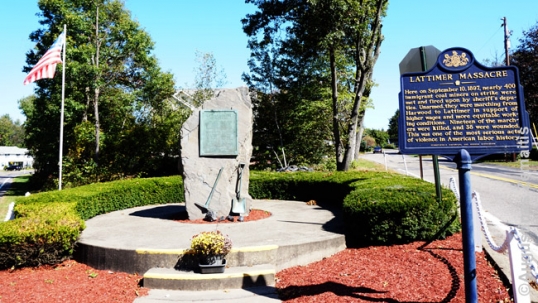
Memorial at the location of Lattimer Massacre
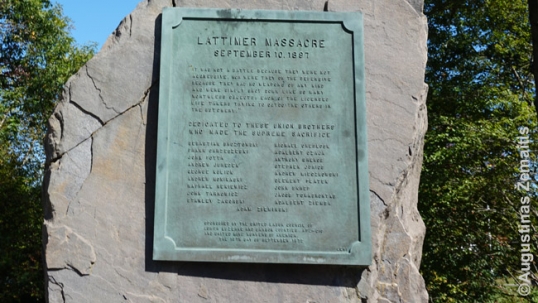
Lattimer Massacre site memorial list of victims

The start place plaque of the Lattimer march, with Lithuanian explicitly mentioned
A nice place to see a Pennsylvania Coal Region town that still looks much like the early Lithuanian migrants found them in the 19th century is the Eckley‘s Miners Village with its rows of wooden homes. It may be visited as a museum and the introductory film describes Lithuanians among its historic ethnicities. The entire town is being slowly converted into a museum as the vacated homes are not filled with new tenants.
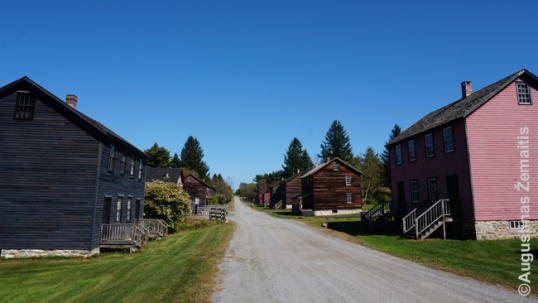
Eckley‘s Miners Village street
The map
All the Lithuanian locations, described in this article, are marked on this interactive map, made by the "Destination - America" expedition (click the link):
Interactive map of Pennsylvania Southern Coal Region Lithuanian sites
Philadelphia, Pennsylvania
Philadelphia is among the "most Lithuanian" cities in the USA and has the fourth largest total number of ethnic Lithuanians after Chicago, New York, and Los Angeles (~6000)
It has 3 great Lithuanian churches, pre-war art nouveau Lithuanian halls, a synagogue named after Vilnius, and an abandoned Lithuanian cemetery in its suburbs.
Lithuanian Music Hall in Philadelphia
The prettiest and the last one surviving among Philadelphia's Lithuanian clubs is its especially old (erected 1908) Lithuanian Music Hall, also known as Lietuvių namai ("Lithuanian House") in Lithuanian language and "Big Lit" in English (2715 E. Allegheny Ave). It is a separate red brick building inspired by art nouveau.

Lithuanian Music Hall in Philadelphia.
Inside, there are three halls, of which the upper floor one is the most impressive. It is named after M.K. Čiurlionis, Lithuania's most famous painter. Previously, it had full arched windows, but those have been partly bricked up during the war shortage times.
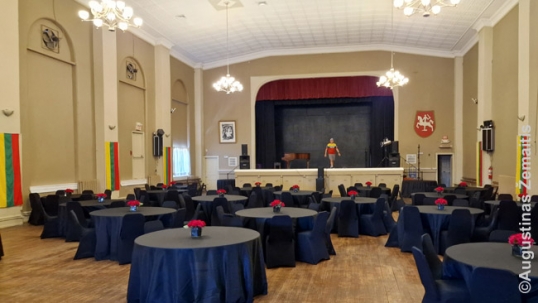
The upper hall of the Lithuanian Music Hall
In the basement, the Hall has an exhibition of Lithuanian arts, both folk and professional, and documents and maps related to the history of Lithuania and Philadelphia Lithuanians. This is the Surdėnas Lithuanian cultural center, established in 1980 and renovated ~2021. There is also a Lithuanian book library. You may also see the authentic heating system from the pre-WW1 era in that room.
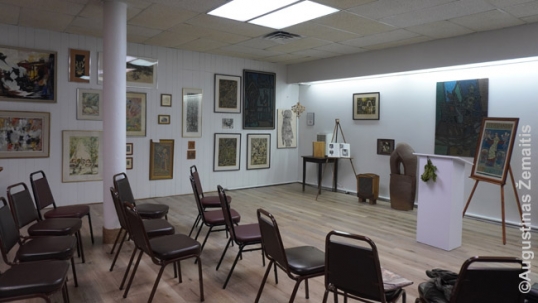
The basement museum of Lithuanian Music Hall
The hall hosts many Lithuanian activities and an annual fair. To this day, it also hosts Lithuanian concerts of the musicians arriving from Lithuania.

Musicla instrument detail at the Lithuanian Music Hall.
The surrounding district is mostly Polish (it is still strong on that identity). Poles too, however, come at the Music Hall's fair and other events.
In 2017, the Lithuanian Music Hall was in peril. There were plans by its mostly elderly owners to sell the building. However, seeing this, some new Lithuanian immigrants joined the organization and took over the management of the building, thus saving it as a Lithuanian cultural hub. The building was renovated.
Lithuanian National Hall in Philadelphia
The second Lithuanian Club of Philadelphia, known as the Lithuanian National Hall, used to be located close to 2nd Avenue. Its building still stands and the name is still chiseled in stones but it has been remodeled into apartments (the Lithuanian Club closed in 1984). In a way it's going back to the roots as when the Hall was completed in 1900 it also included apartments. Afterward, the expanding Club needs and rental halls had pushed the residential use out.

Lithuanian National Hall in Philadelphia.
St. Andrew: the grandest of Philadelphia's Lithuanian churches
Philadelphia still has all three of its Lithuanian churches open.
Towered neo-romanesque St. Andrew Church (1913 Wallace St.) still hosts Sunday mass in Lithuanian. The building has been acquired from Protestants in 1942 after the Great Depression and War shattered hopes of the parish to erect its own new building.

St. Andrew Lithuanian church in Philadelphia.
St. Andrew has a grand interior, the most impressive among Philadelphia's Lithuanian churches.

St. Andrew Lithuanian church in Philadelphia (interior).
Despite the non-Lithuanian origins of the building, St. Andrew's church has many Lithuanian details, ranging from a freestanding wayside cross outside to a true "Shrine of Lithuanian history" inside.
On that shrine, one may see a railroad going towards a cross, which is a symbol of the Soviet Genocide (1940-1953) when hundreds of thousands of Lithuanians, some third of them children and babies, were forced into cattle carriages and moved to the ice-cold Siberia where many of them died due to cold, hunger, forced labor, and other reasons.
There is also a cross with images of the victims of the January 13, 1991 massacre, a final Soviet bid to stop Lithuanian independence. Lithuanian civilians were stopping the tanks with their bodies then and many died. Vilnius TV Tower, one of the key locations Soviets attempted to take over, is also painted there. There is also the Our Lady of Vilnius in a folk-craft-inspired wooden frame and a Lithuanian flag.
Soviet Genocide is an important topic here, as much of the congregation has originated in the refugees who fled Lithuania before the Soviet re-occupation in 1944. These refugees always saw themselves as exiled people, as staying in Lithuania would have meant death to nearly all of them (or another exile to Siberia, a much worse location).

St. Andrew 'Shrine of Lithuanian history'. From left to right: American, Lithuanian, and Vatican flags; the Soviet Genocide painting; the Mary painting in a folk-craft frame; the TV tower painting; the cross with images of those killed in January 13, 1991.
The church also has Lithuanian religious images. Over the altar, Lithuanians Mečislovas Reinys (a Lithuanian priest killed for refusing to collaborate with the Soviets) and Marija Kaupaitė (the venerable founder of a Lithuanian-American nun order) are painted. Near the altar, Jurgis Matulaitis, a beatified Lithuanian has his image in a large folk-art frame. Outside, there is a Lithuanian wooden cross.

St. Andrew Lithuanian church in Philadelphia Mečislovas Reinys and Marija Kaupaitė over the altar, with a traditional Lithuanian sun-cross in between.
There are still some curious details left from the Episcopal era, such as numbered pews (in the Episcopal church, they used to be rented to families but in the Lithuanian church, anybody is free to sit anywhere). Before using this church, the Episcopals had a small church nearby. Today, it is also owned by the Lithuanian parish and used as a parish hall, as well as Vincas Krėvė Saturday school where Philadelphia Lithuanian kids learn the Lithuanian language and culture.
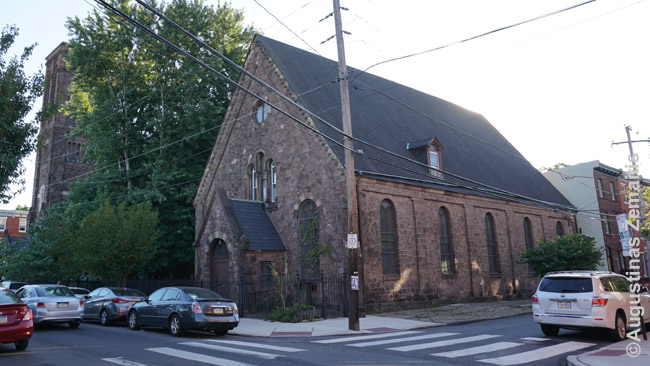
Exterior of the former Episcopal church (now St. Andrew parish hall and Vincas Krėvė school).
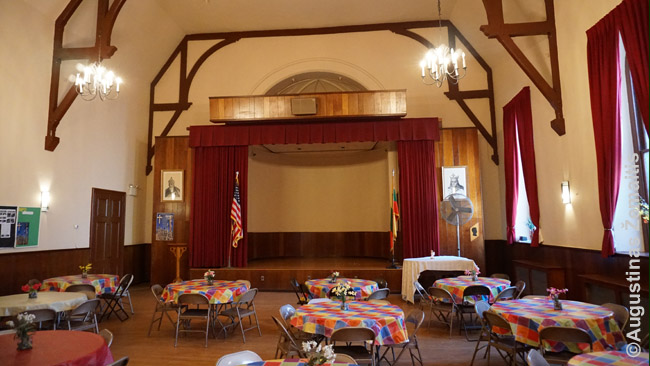
St. Andrew Lithuanian church in Philadelphia parish hall.
There were Lithuanian details even in the rectory of St. Andrew's, however, it has been sold ~2022.
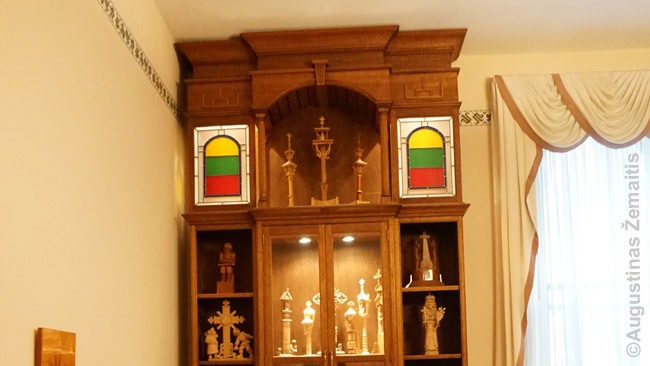
Lithuanian details at the sacristy of St. Andrew.
St. Casimir: the most Lithuanian church in Philadelphia
While St. Andrew Lithuanian church has many Lithuanian details, it couldn't compare with St. Casimir Lithuanian church of Southern Philadelphia (324 Wharton Street).

St. Casimir Lithuanian church in Philadelphia. A Lithuanian tricolor is waving nearby.
There, the Lithuanian details are nearly countless. At the entrance, a Lithuanian quote "Izenk geras, iseik gerensis" ("Enter a good person, leave a better one") greets the people. Inside, the stations of the cross are all done on Lithuanian designs, there are paintings like the opening of St. Casimir's grave in Vilnius Cathedral, there are stained glass windows of Marija Kaupas and much more.

St. Casimir Lithuanian church in Philadelphia stations of the cross, with Lithuanain inscriptions and Lithuanian traditional ornamentation. A Lithuanian tricolor is waving nearby.
In fact, nearly everything here has a relation to both religion and Lithuania. For example, among the images of the saints, blessed people, and the venerable, many are either from Lithuania or Lithuanian-Americans. The Lithuanian atmosphere was supported by priest Petras Burkauskas, a long-term Lithuanian priest in the church (1996-2021).

Altar of the St. Casimir Lithuanian church in Philadelphia. The slogoan on tops, surrounded by two Lithuanian flags, declares: 'St. Casimir. Wonderful on earth, more wonderful in heaven.'
Outside, there is a traditional Lithuanian chapel-post and the inscription at its bottom even describes it as having both Christian and Pagan motifs. This is a fact, as the Lithuanian folk motifs (such as the sun often found on the traditional crosses) are undoubtedly pagan-inspired even though undeniably Christian today. Yet, few churches dare to recognize this. However, Lithuanian-American churches are built on two pillars, religious and ethnicity, and that ethnic pillar includes the non-Christian Lithuanian history as well.

St. Casimir Lithuanian church in Philadelphia entrance. A Lithuanian tricolor is waving nearby.
St. Andrew is also the sole place among Philadelphia Lithuanian buildings where a Lithuanian tricolor is permanently waving.
St. Casimir is the oldest Lithuanian church (parish established in 1893) but the current building was erected after a fire in 1930. In 2007 its 100-year old school has been closed while in 2011 the parish has been amalgamated with St. Andrew but the church remaine dopen.
St. George: the church of blue-collar Lithuanians
St. George Lithuanian church (3580 Salmon Street) has two floors, the first of them built for a school and still used as such. Non-Lithuanian kids predominate now, but the entrance still has Vytis (the Lithuanian Coat of Arms) on it and there are other Lithuanian details inside. Stations of the cross have Lithuanian inscriptions, there is a medal to the Lithuanian king Jogaila and much more.

St. George Lithuanian church in Philadelphia.
The St. George church building was erected in 1920, with the school being preferred to a tower. The former church building stands nearby, now serving as a parish hall.
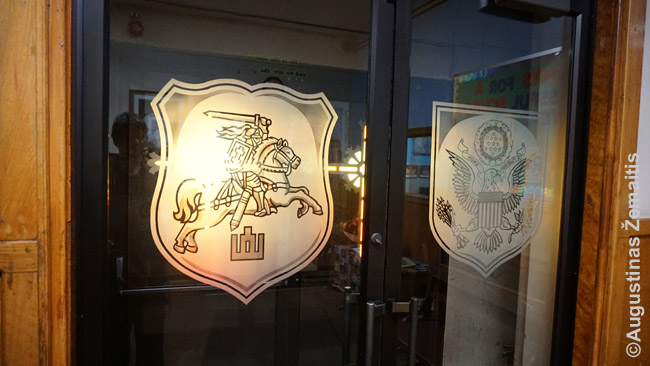
St. George Lithuanian church in Philadelphia. Entrance with the Lithuanian Coat of Arms.
Traditionally, St. George church used to be frequented by the blue-collar Lithuanian workers (in contrast to St. Andrew, which was a domain of intellectuals, especially the Soviet-Genocide-refugees). Therefore, it is the most modest among the three Philadelphia Lithuanian churches. Still, it has nice Lithuanian-donated stained glass windows with donors' names under them.
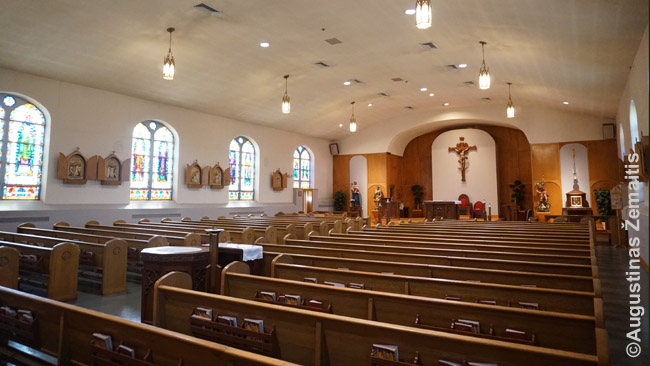
St. George Lithuanian church in Philadelphia interior.

The bottom of St. George Lithuanian church in Philadelphia stained glass windows with Lithuanian donors marked.
Vilna Congregation (Vilnius synagogue) in Philadelphia
A rather unique Lithuania-related site is the Vilna Congregation, named after Vilnius, the capital of Lithuania (Vilna being its old Russian name). This is a synagogue located in a house once owned by Shapiro, a Jewish person from Vilnius. He promised God that should his business succeed, he'd donate his home for the religion (and this is what happened). He cquired the building in 1915 and registered it as synagogue in 1922. The inscription chiselled in stone above the entrance reads (in Hebrew script) - "The Avraham Aba Bar Shapira and Men of Vilna Synagogue established in the year 5665".

Vilna Congregation synagogue in Philadelphia (exterior).
Eventually, the original "Men of Vilnius" who worshipped there have left the area and the synagogue is now kept by the Chabad Lubavitch movement. While it has few worshippers, the rabbis seek to keep it open.

Vilna Congregation synagogue in Philadelphia.
The word "Vilna" is still visible on numerous locations inside. The synagogue, however, has collected donor plaques from the area's other synagogues, so, not every plaque is originating at Vilna Synagogue. There is also the establishment charter on the second floor, as well as newspaper clippings about the synagogue's history and the images of the synagogue founders who came from Vilnius.

Vilna Congregation synagogue in Philadelphia plaque with 'Vilna' name mentioned.
The synagogue is usually closed outside of prayer times.
Lithuanian Republican Citizens' Club
Port Richmond neighborhood that is the home for St. George Lithuanian church as well as the Lithuanian Music Hall also has a third Lithuanian-originated institution known as Lithuanian Republican Citizens' Club. While it still operates, it now operates more as a private bar without ethnic activities. As of 2022, it has ~60-70 members of whom only one is a true Lithuanian. An abbreviation "L.R.B.C." is remaining on the sign outside (it means Lithuanian Republican Beneficial Club).

Lithuanian Republican Club
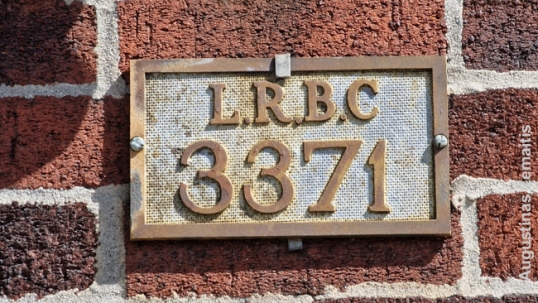
Lithuanian Republican Club abreviation
Bensalem abandoned Lithuanian cemetery (National Catholics)
The saddest Lithuanian site in Philadelphia is the abandoned Lithuanian cemetery at Bensalem suburb (est. 1926). Once owned by the unique and independent Lithuanian National Catholic church, the cemetery became abandoned after most Lithuanians returned from that church to the Vatican-led Roman Catholic church.

Bensalem Lithuanian cemetery entrance.
Currently, the cemetery is so overgrown that it requires a painful push through spiky plants to access some of the graves (what you see near the road is just part of the cemetery; the other parts are deeper into the forest). Still, that makes the cemetery unique and interesting to those who like such abandoned sites.
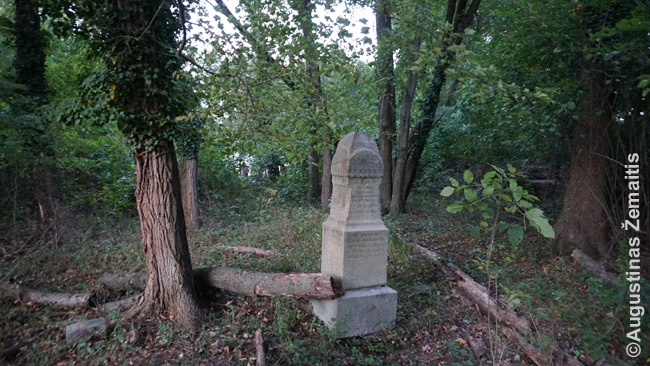
A grave deep inside the Bensalem Lithuanian cemetery.
The Lithuanian National Catholic parish existed in years 1926-1957 and had some 400 members at the start. Their St. Mary church was located at 331 Reed Street which is now an empty lot.
Lithuanian churches of Chester (PA) and Camden (NJ)
In addition to the Philadelphia's three Lithuanian churches in the city-proper, there were two more Lithuanian churches in the Philadelphia suburbs of Chester and Camden (NJ). Both of these buildings have been demolished, however. Chester church has been closed in 1972.
Villa Joseph Marie High School
Villa Joseph Marie high school was established in 1932 as a Catholic school for mainly Lithuanian girls by the Sisters of St. Casimir, a Lithuanian female monastic order of USA. It originally used the historic Maria Hall but got a new building in 1957. A nursing home used to stand on the grounds back then as well, now its former premises have been assumed by the school.
Lithuanian memorabilia near Philadelphia's Independence Hall
Philadelphia is the birthplace of US independence and, as such, it has inspired independence movements elsewhere in the world, especially so during the ~1850-1950 century when the global empires were slowly disintegrating. During World War 1, the opportunity to declare independence reached Lithuania and Central Europe. Thus, in 1918, delegates of various Central European nations, among them Lithaunians, met in Philadelphia to sign their declaration of common aims. This declaration is now exhibited in the museum of Philadelphia's Independence Hall.
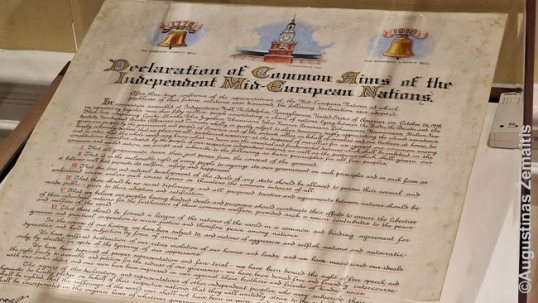
Declaration of Common Aims
Recommended literature: "Where Have All the Lithuanians Gone? A Study of St. Casimir’s Lithuanian Parish in South Philadelphia"
The map
All the Lithuanian locations, described in this article, are marked on this interactive map, made by the "Destination - America" expedition (click the link):
Interactive map of Philadelphia Lithuanian sites
Destination America expedition diary
|
Philadelphia may be the Lithuanian America as it once was. All three of its Lithuanian churches are open, two of them decorated elaborately with many Lithuanian details by their long-term priest Petras Barkauskas.
There is a Philadelphia Lithuanian school with its own premises, there is yet another Lithuanian priest Joseph Anderlonis (who guided us around), and the Lithuanian St. George Lithuanian parish still has its own parish school open. There is also the Philadelphia Lithuanian Music Hall, a great art nouveau-styled edifice with a lyre above its entrance. It is older than the Republic of Lithuania itself. And there is even a synagogue named after Vilnius – in a house donated by a Jewish man who made a promise to God to do that if his business succeed. The rabbi we met considered the synagogue’s survival quite miraculous on itself since it is so small and easily convertible back into a house; however, a cooperation of different groups of Jews made it possible. However, dangers are looming on top of the Philadelphia Lithuanian sites, as there are talks to sell the Lithuanian Music Hall, cutting its 110-year-old Lithuanian history for good. It would be a pity to lose yet another key Lithuanian-American site, especially since the Hall could be easily saved if there would be more cooperation among different groups of Lithuanian forces in America: if the “old Lithuanian-Americans” who are currently the ones caring for the Hall would be joined by the Lithuanian embassy and consulates, the “new Lithuanian-Americans”, the descendants of the “old Lithuanian-Americans”, the Lithuanian-Americans from outside Philadelphia, the non-Lithuanian Americans who are into heritage protection, and more. It depends on all of us to prevent Philadelphia from becoming yet another once-very-Lithuanian American city where barely anything Lithuanian remains! Augustinas Žemaitis, 2017 10 02. |

Tikslas - Amerika vadovas Augustinas Žemaitis su Filadelfijos lietuviais Šv. Andriejaus parapijos salėje
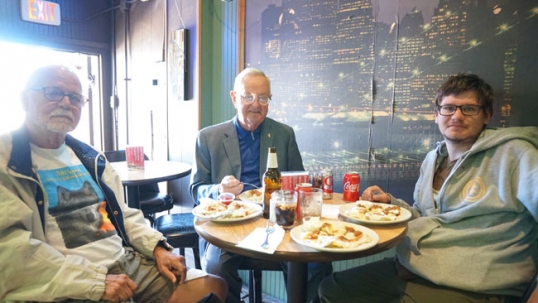
Tikslas - Amerika projekto vadovas Augustinas Žemaitis su Filadelfijos lietuvių muzikos salės atstovais
Du Bois, Pennsylvania
Although DuBois is a rather small city (pop. 20000), it had an especially old St. Joseph Lithuanian Church that was founded in the 19th century. The current Romance Revival building was erected in 1924 (State St and South Ave corner). Inside there are pretty stained glass windows with the names of Lithuanian donors, while the basement used to serve as a parish hall. In 2012, after some older Lithuanian parishes were closed, the DuBois church became the oldest surviving Lithuanian parish in the Americas. However, the church was closed and sold to the Orthodox Christians in 2018. The cornerstone says "St. Josephs Lithuanian R C Church AD 1924".

DuBois Lithuanian church.

The interior of DuBois Lithuanian church.

The bottom of the stained glass window with the name of the organization that sponsored it written.
DuBois Lithuanians are traditionally buried in a separate St. Joseph Lithuanian cemetery. The cemetery has wooden freestanding stations of the cross (a unique arrangement) that mark the cemetery quarters. Each station has a name of a Lithuanian donor on them (some stations have been lost, however).

DuBois Lithuanian cemetery with the wayside shrine in the distance.
Moreover, the cemetery has a large Wayside shrine that was built with the support of the Knights of Lithuania organization in memory of the parish priests Urbonas, Barr, and Rakauskas in 1979. The three crosses once had wooden sculptures on them but they have since deteriorated and were removed. St. Joseph statue that used to stand in front of the now-closed Lithuanian church has also been moved to the cemetery.

Wayside shrine of the DuBois Lithuanian cemetery.
Lithuanians make up 3% of the Du Bois inhabitants.
Previously, Du Bois also had a Lithuanian Independent Club which has been closed since ~2002 after alleged financial improprieties by some officers. It had been opened in 1900 and had its current building completed in 1960 (according to the cornerstone). The "Litts Club" name still remains on one sign, but the main name is now "Luigi's Villa" and the building is used for wedding receptions and other functions. As a Lithuanian Club, it failed to outcompete the nearby Polish club, which, jokingly, was mentioned as one of the goals when erecting the new clubhouse.

Surviving sign of the DuBois Lithuanian club.
The map
All the Lithuanian locations, described in this article, are marked on this interactive map, made by the "Destination - America" expedition (click the link):
Osceola Mills
Osceola Mills is a town of 1500 in Pennsylvania. Originally a coal mining and a lumber mill town, it has attracted a considerable Lithuanian community ~1900. To this day, their Osceola Mills Lithuanian club operates.

Entrance to the town of Osceola Mills
The Lithuanian club is a white wooden building with no external signs. Inside, there is a bar hall and a larger events hall. There are details reminding us of the clubs' Lithuanian heritage, such as Lithuanian emblems and flags, which also appear on the club‘s shirts. However, since some 1960s, non-Lithuanian members have been also allowed to join, and, by now, with the settlement of the town having taken place so long ago, most of the town inhabitants are mixed or know relatively little about their heritage.

Osceola Mills Lithuanian club

Osceola Mills Lithuanian club

The shirt of Osceola Mills Lithuanian club
The Lithuanian club also owns a large Lithuanian cemetery. Most of the land there is, however, empty, as the community never reached the expected size, likely due to the Great Depression of 1929 obliterating the town's coal mining industry (which never fully recovered, and thus never really attracted that many immigrants anymore). Less than 50 people were buried in the cemetery. At first, only those who joined the club below 40 years of age had a right to be buried there but this has been extended to 50 years since. Other Lithuanians are buried in Polish or general Catholic cemeteries of the town.

Osceola Mills Lithuanian cemetery
Lithuanian club started as the St. Anthony Beneficial Society, incorporated in 1907 (and, in the Lithuanian cemetery, there is a cross dedicated to the St. Anthony's Beneficial Society). In many historic Lithuanian communities of the era, Lithuanians would establish such religious fellowships which typically would then become Lithuanian parishes that would have built their own churches, with secular activities and schools also becoming a part of those parishes. With Osceola Mills being heavily hit by the Great Depression, however, no Lithuanian church was ever built, while the club itself slowly lost its semi-religious character, operating more like a bar these days.
Original documents of the Society has some 100 members listed ~1919. A 1916 document hanging on the wall in the club also shows that the organization (or some of its key members) was affiliated to Lithuanian Alliance of America as its Lodge No 256. Society's documents were written in the Lithuanian language until ~1940s and in English since then.
In addition to the Lithuanian club, there is a Slovak club in town while the Polish club no longer exists. There is a Polish cemetery and a Russian Orthodox church and cemetery, as well as the (largest) general Catholic cemetery. There are likely Lithuanian graves in the Polish and the general Catholic cemeteries as well.
Osceola Mills is far from any other Pennsylvanian towns that have Lithuanian heritage sites. The closest Pennsylvanian town has a Lithuanian cemetery is Portage almost 100 km away. While there are numerous burials with obviously Lithuanian names there, only one lists the buried person as a Lithuanian. Many burials date to the era around World War 2.

The only grave in Portage Lithuanian cemetery with Lithuania specified on gravestone

As was common in the times, Lithuanian names changed in America. In this case, the same woman's name is written differently on different memorials on her own grave; while the main gravestone has hear as "Agota Ambrazevicze", the smaller post has her as "Agata Ambrazatas". Likely real name was "Agota Ambrazevičienė" or "Agota Ambrazaitienė".
Easton, Pennsylvania
Easton (pop. 70 000, ~0,5% Lithuanians), a suburb of Allentown had its St. Michael Lithuanian church. It is a pretty Gothic Revival building with an old rectory.

Easton Lithuanian church
The church building has been originally constructed in central Easton in 1854 by the Presbyterian church and used by Civil War veterans in 1896-1916. It has been acquired by Lithuanians in 1916. The art deco stained-glass windows were installed then. In 1958, the original wooden spire has been replaced by a metal spire after being destroyed by lightning. In 1971, the interior of the church has been simplified.
St. Michael Lithuanian church closed in 2008 and acquired by a film studio Lou Reda Productions in 2011.
The studio uses the building for storage of their material and as an office for post-production. According to the current owner of the studio Scott Reda, they purposefully searched for a church to acquire in order to have an expansive space for cinema reels.

Easton Lithuanian church interior
No Lithuanian details remain on the building and most likely few existed even before the sale of the building.

Storage in the interior of Easton church
Since 1934, the Easton Lithuanian parish had its own Mary Magdalen Cemetery. The land was donated by a local Lithuanian Martin Lychius, whose name is now thus inscribed on the cemetery gate.

Easton Lithuanian cemetery gate

Easton Lithuanian Cemetery memorial
The map
All the Lithuanian locations, described in this article, are marked on this interactive map, made by the "Destination Lithuanian America" expedition (click the link):
Map of Lithuanian heritage in Mid-Atlantic
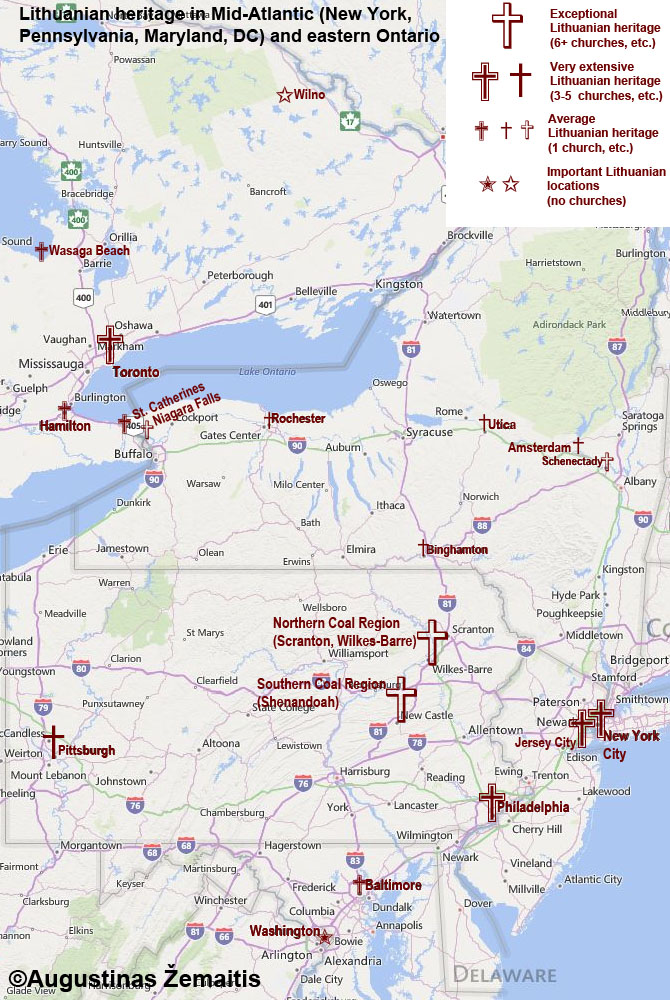
Map of the Lithuanian heritage in Mid-Atlantic (New York, New Jersey, Pennsylvania, Maryland, DC) and western Ontario.
More info on Lithuanian heritage in Maryland, New Jersey, New York, Pennsylvania, Washington, DC, Ontario.
Reading, Pennsylvania
Reading city has a white Lithuanian St. Anthony church. The building does not look like a church from the front, however, it certainly looks like a church from the side. That's because a regular building was acquired by Lithuanians in 1913 and put into church use. While the community remained for a long time and was still an officially Lithuanian parish at the end of the 20th century, actually, non-Lithuanians joined it quite quickly and so Lithuanian details likely disappeared long before the church was closed. In 1920, for example, Reading had only 54 Lithuanians.

Reading Lithuanian church
The map
All the Lithuanian locations, described in this article, are marked on this interactive map, made by the "Destination Lithuanian America" expedition (click the link):

